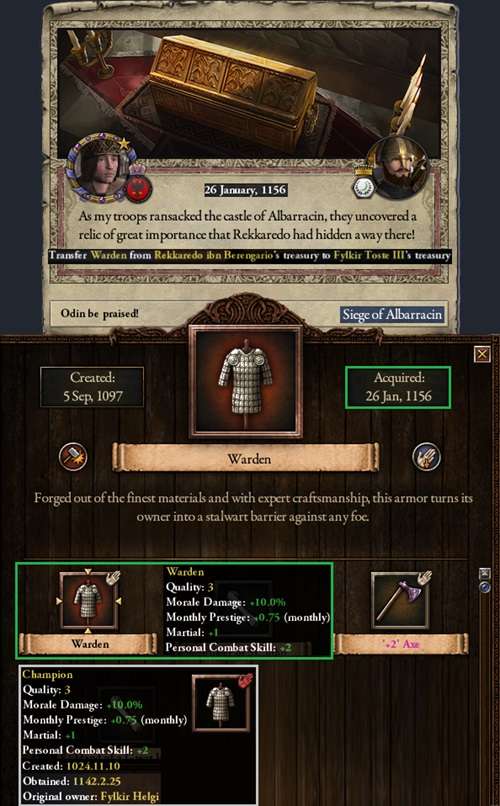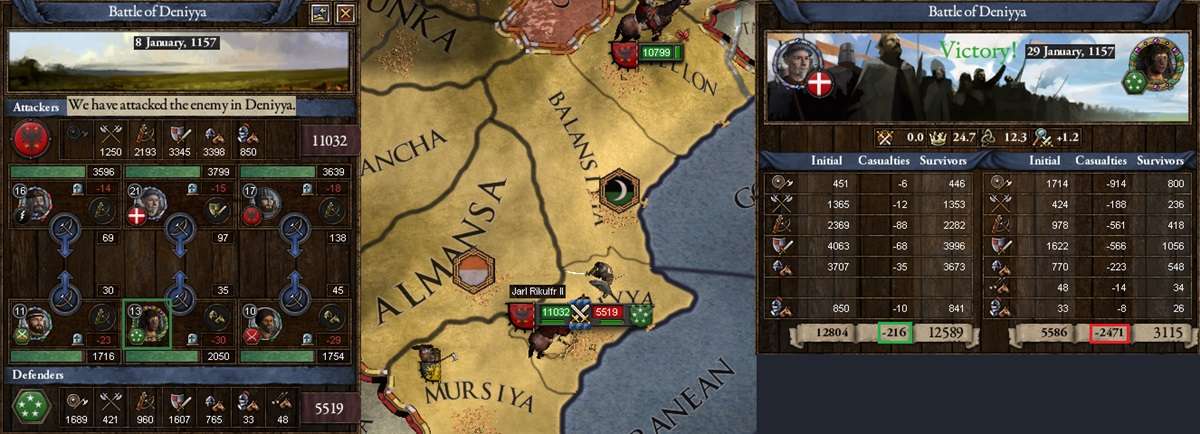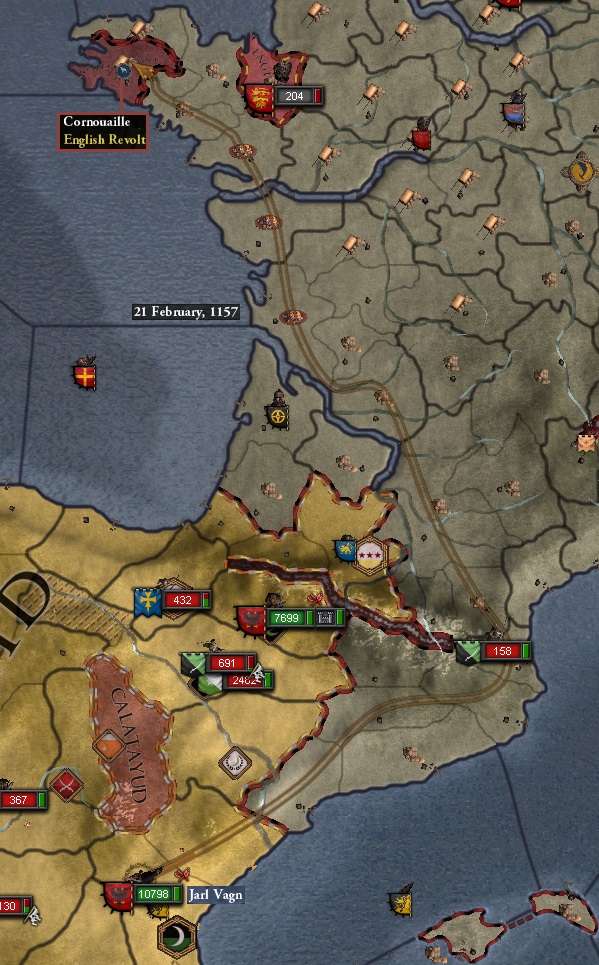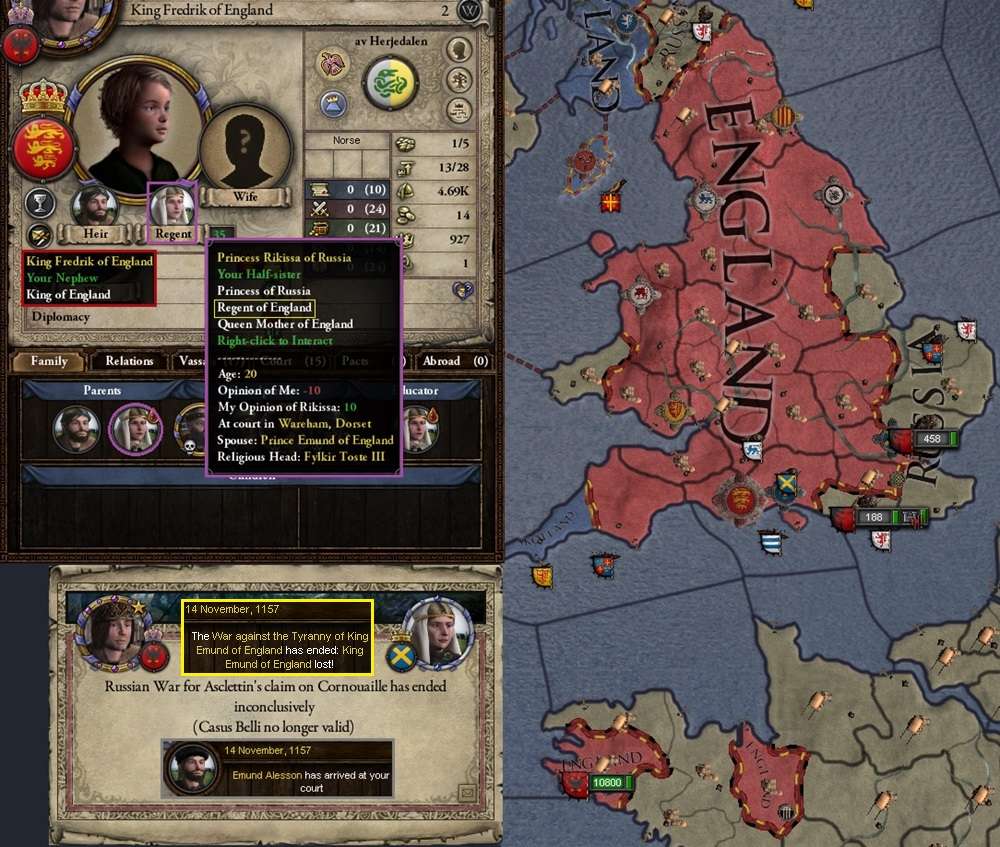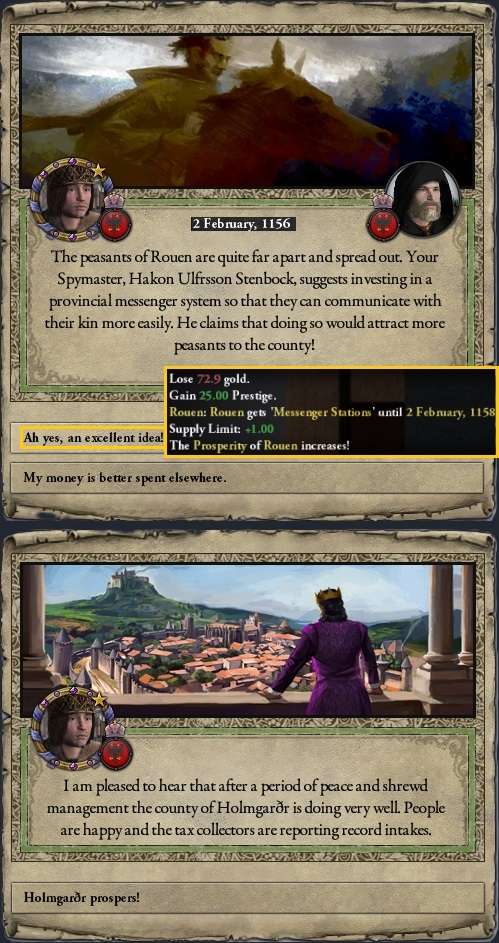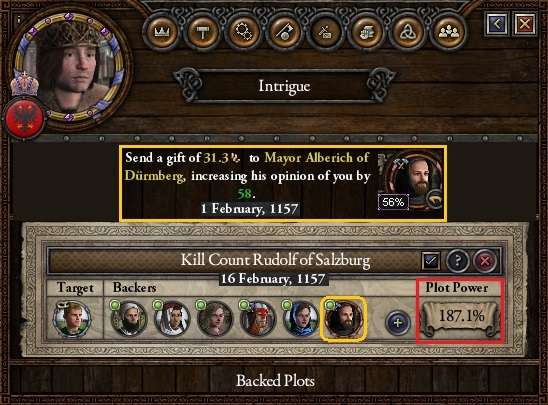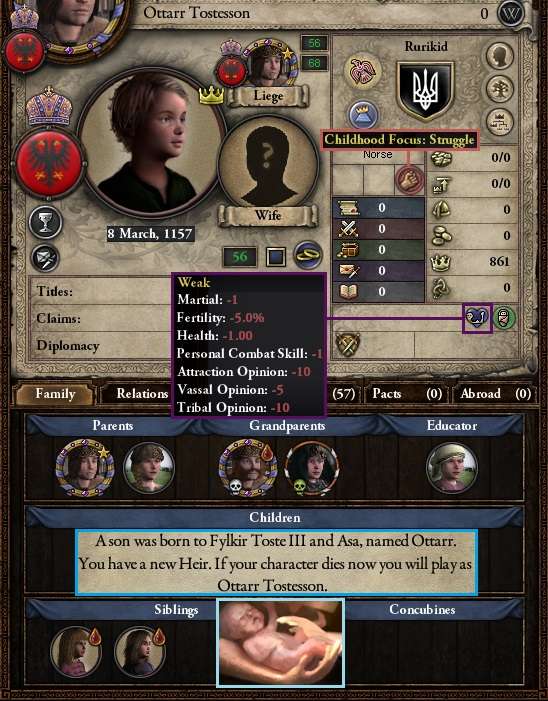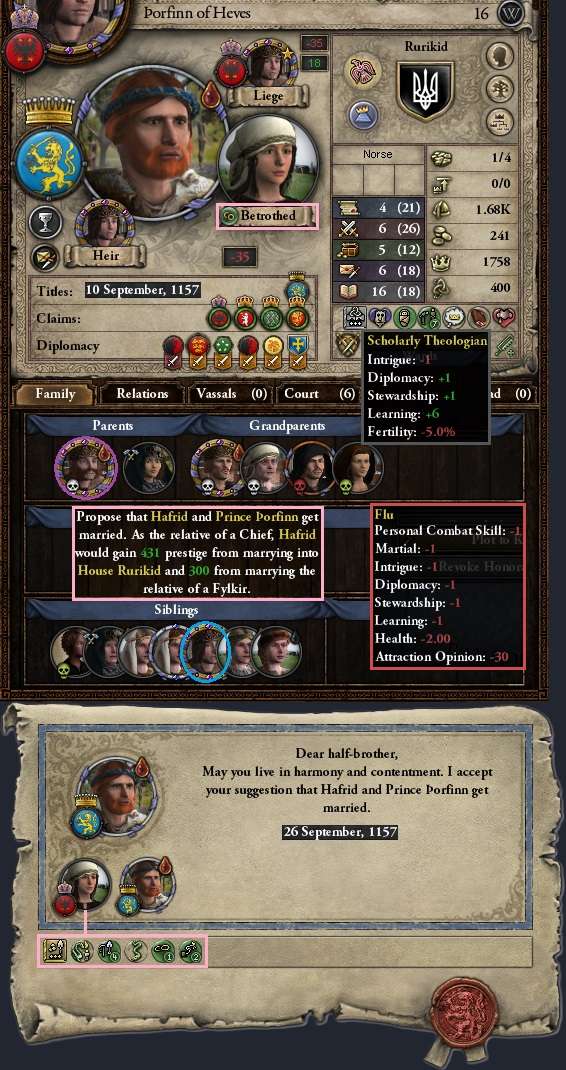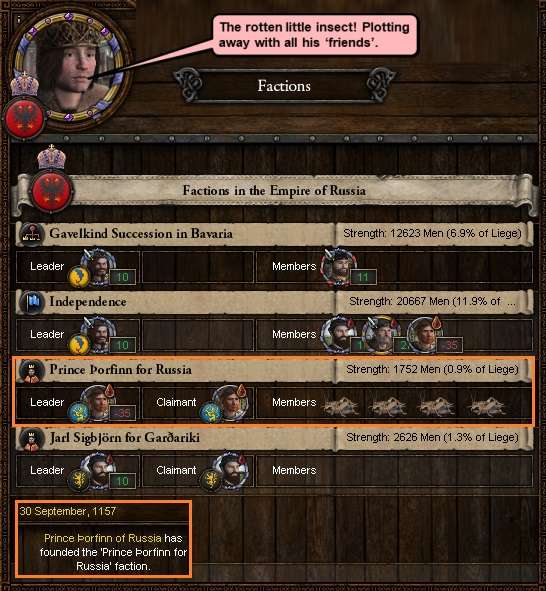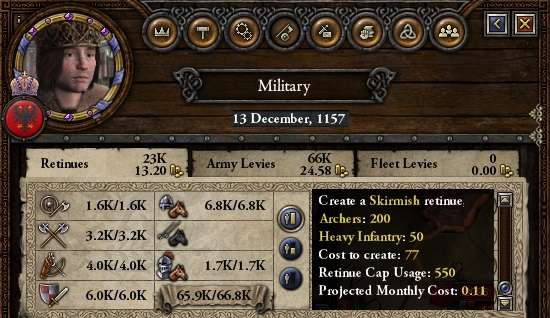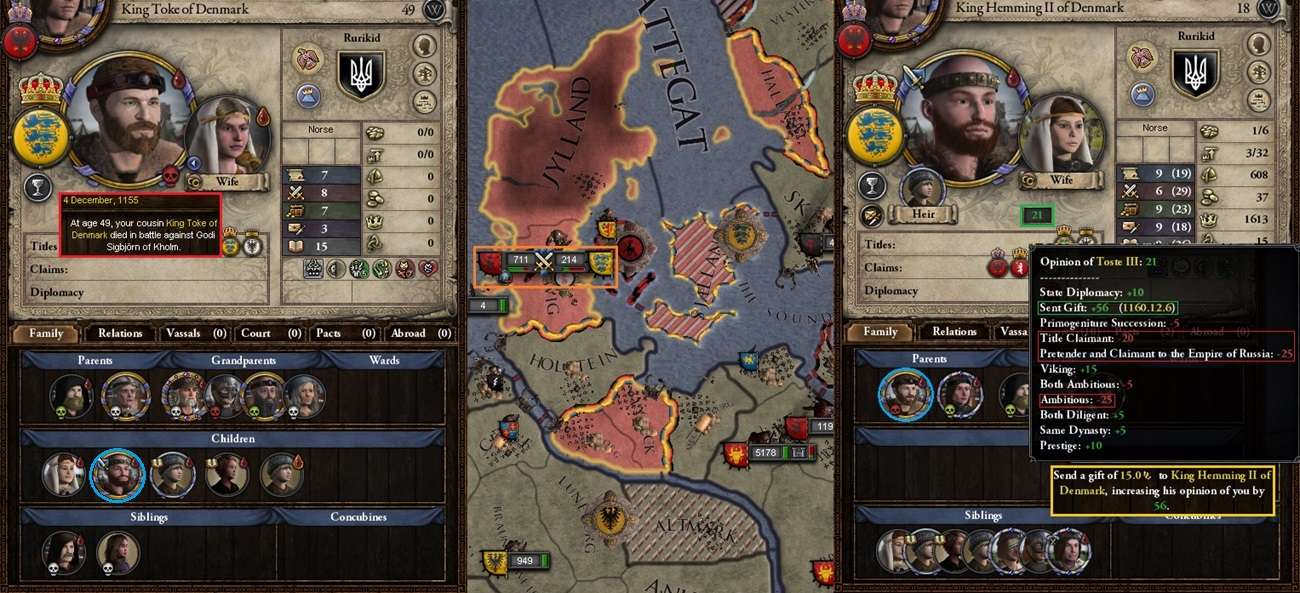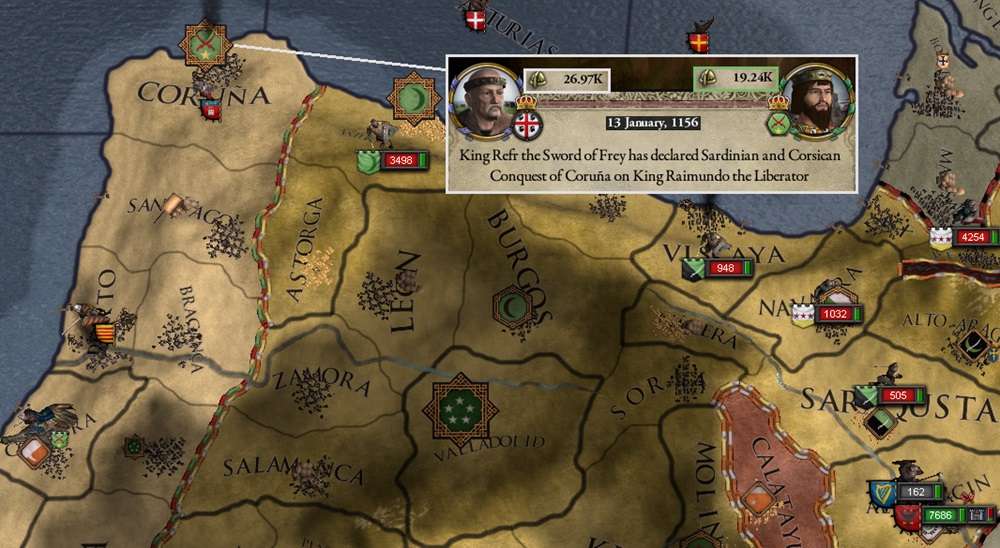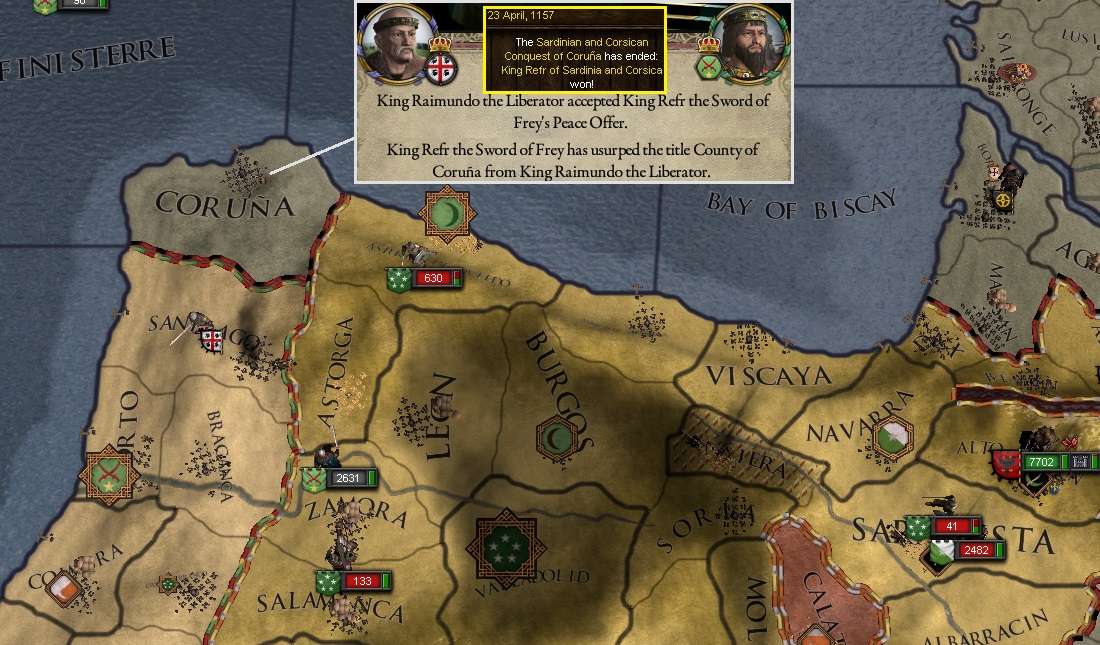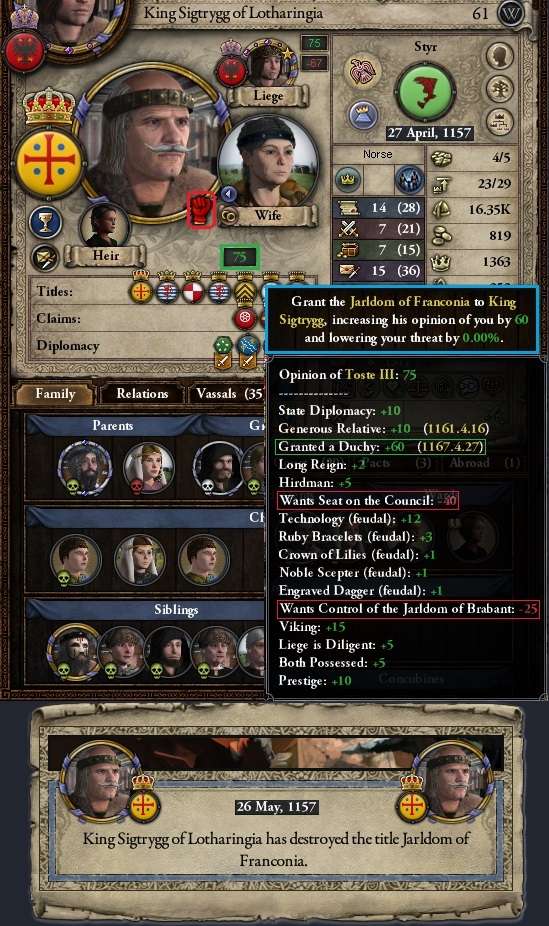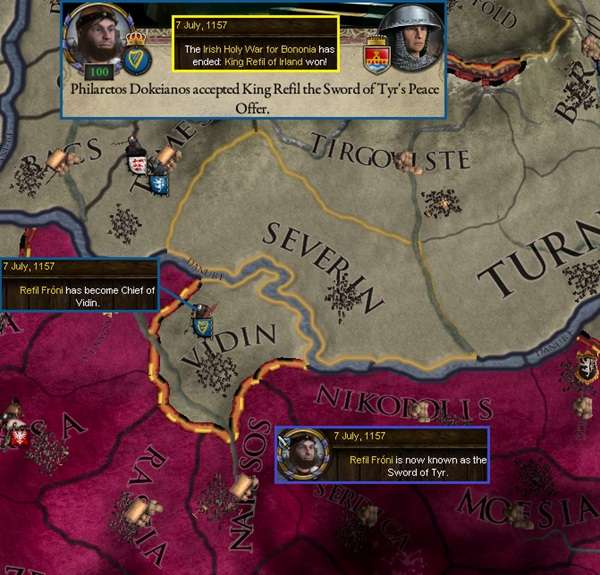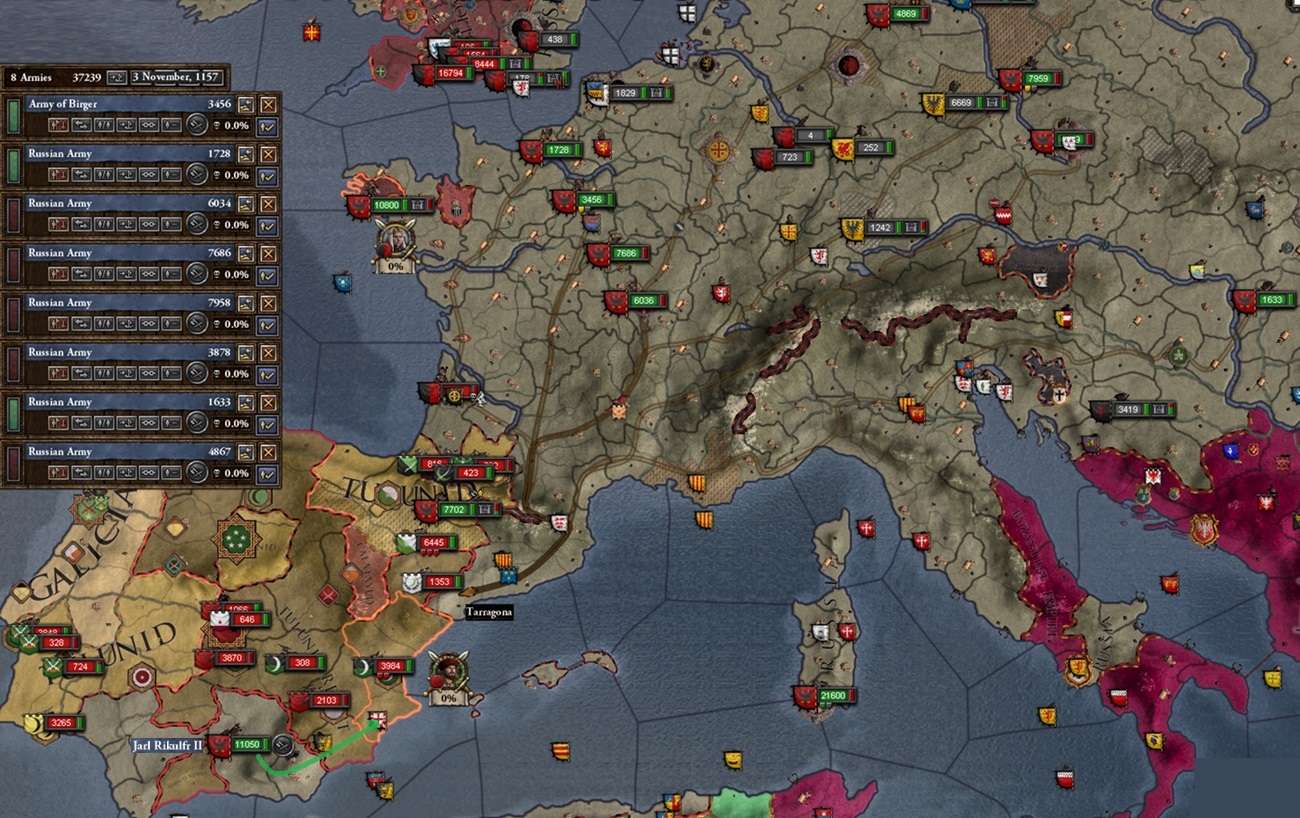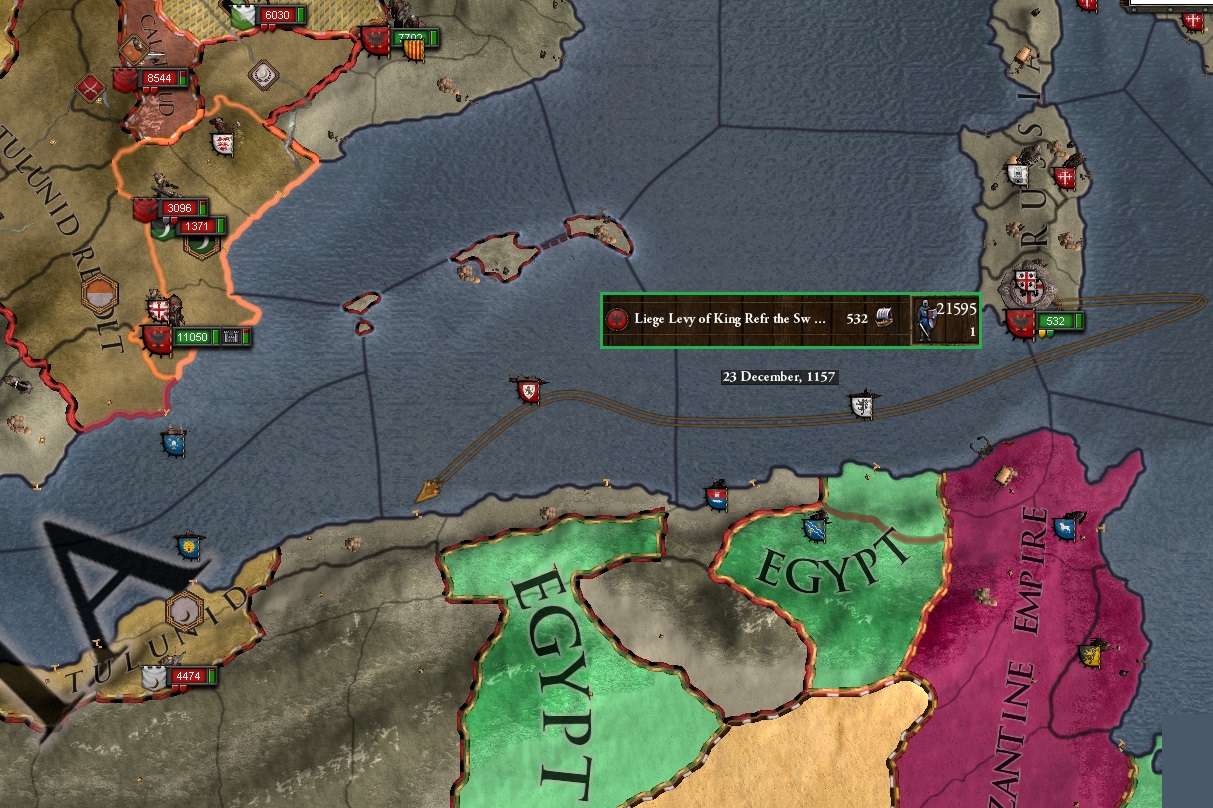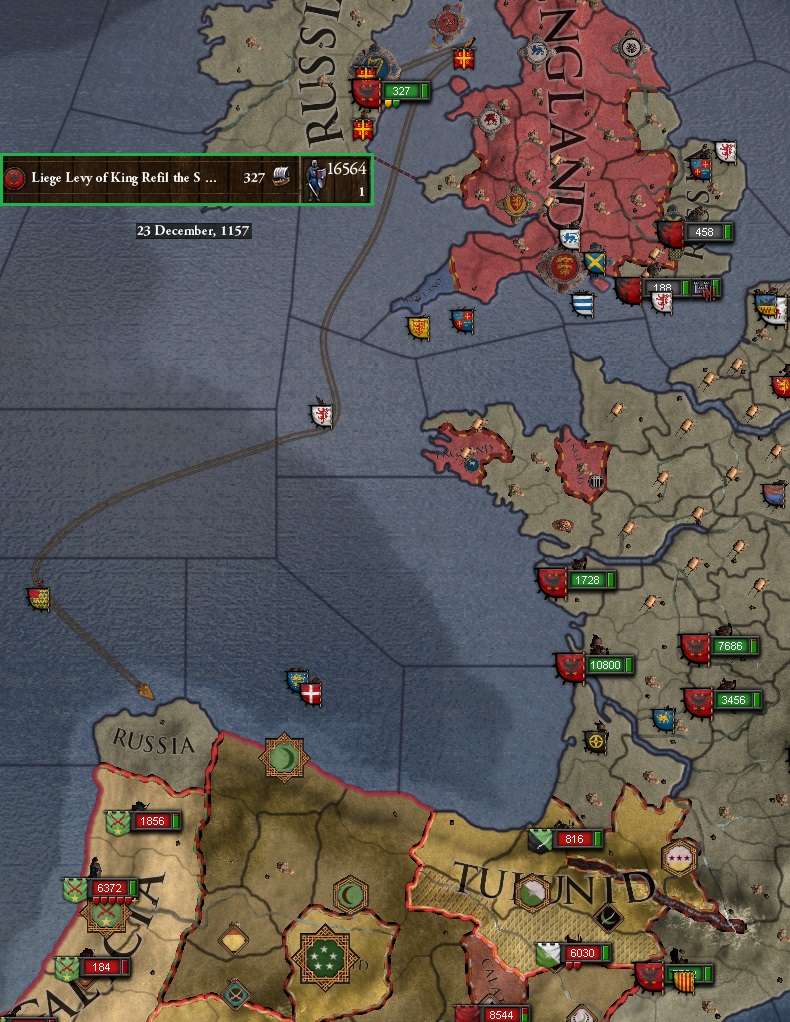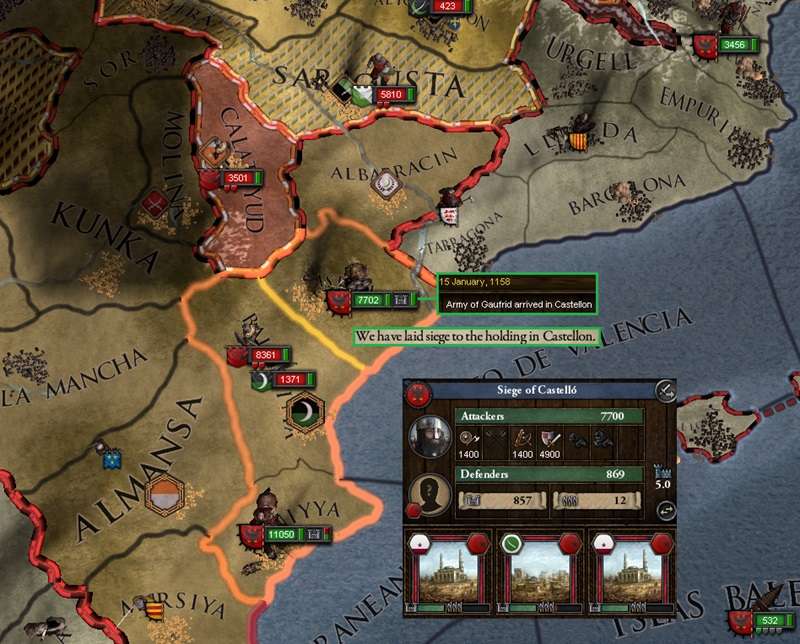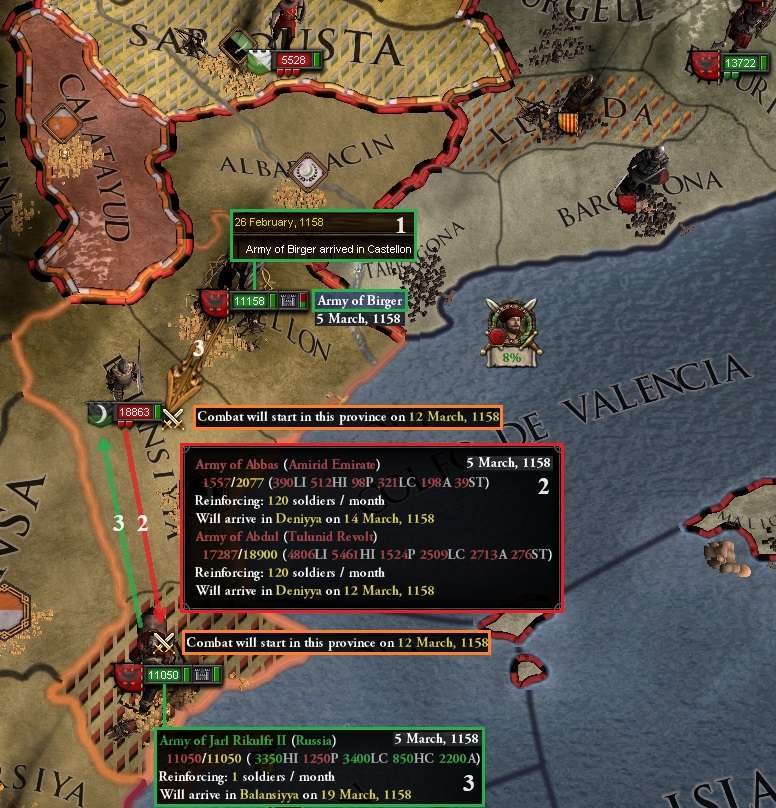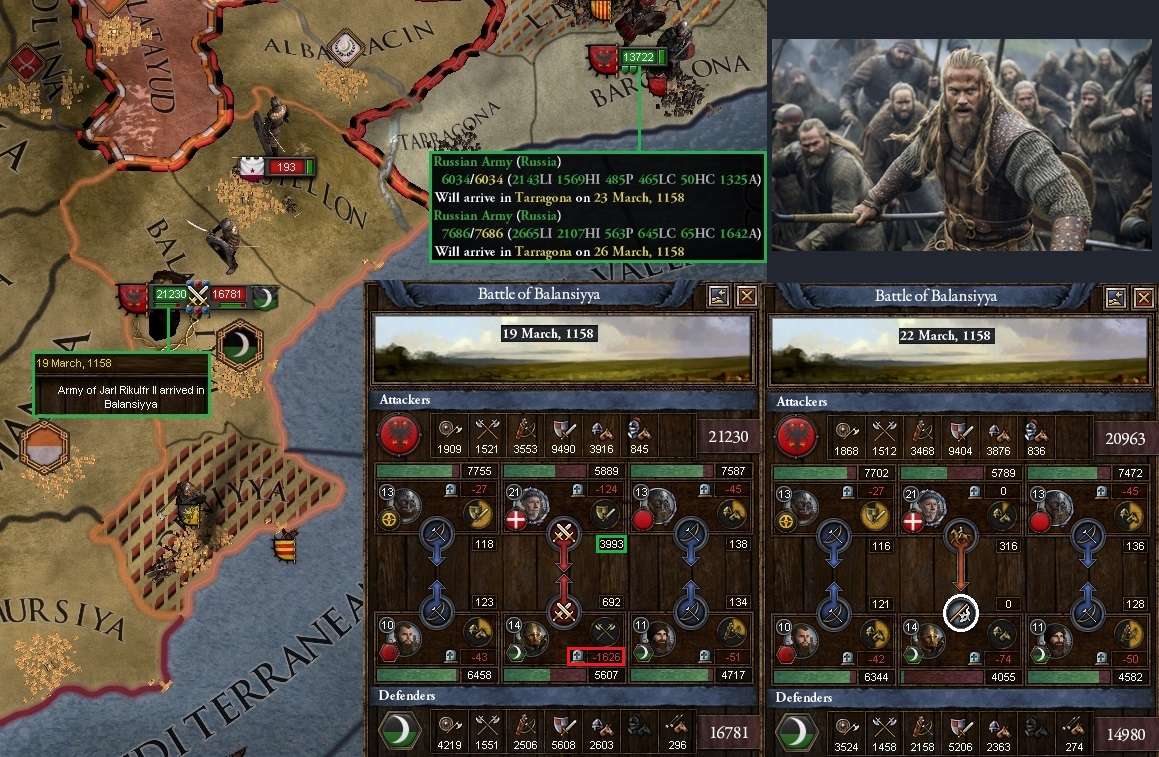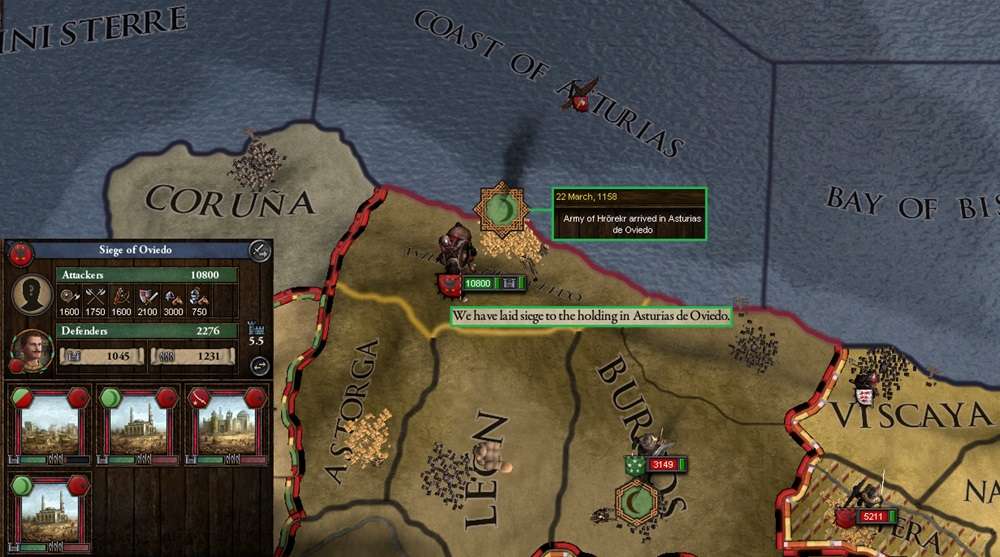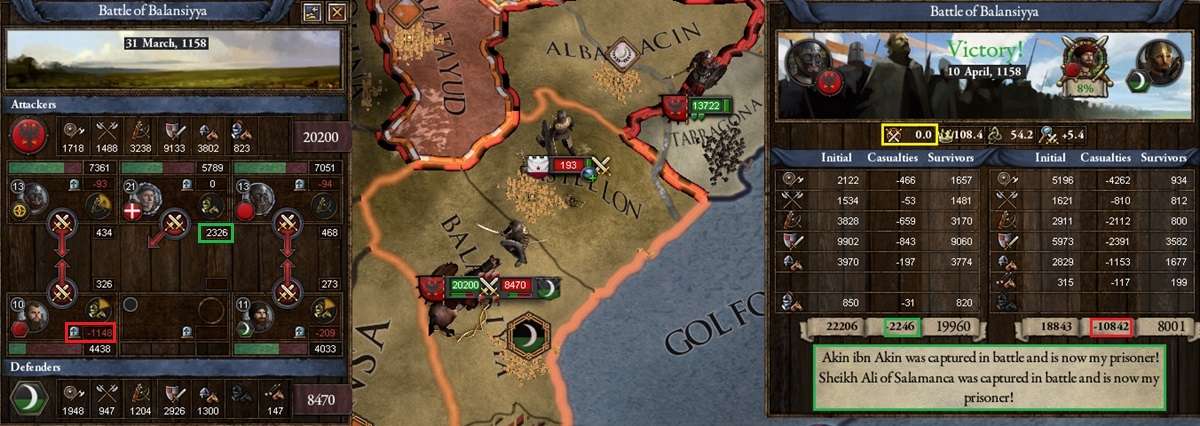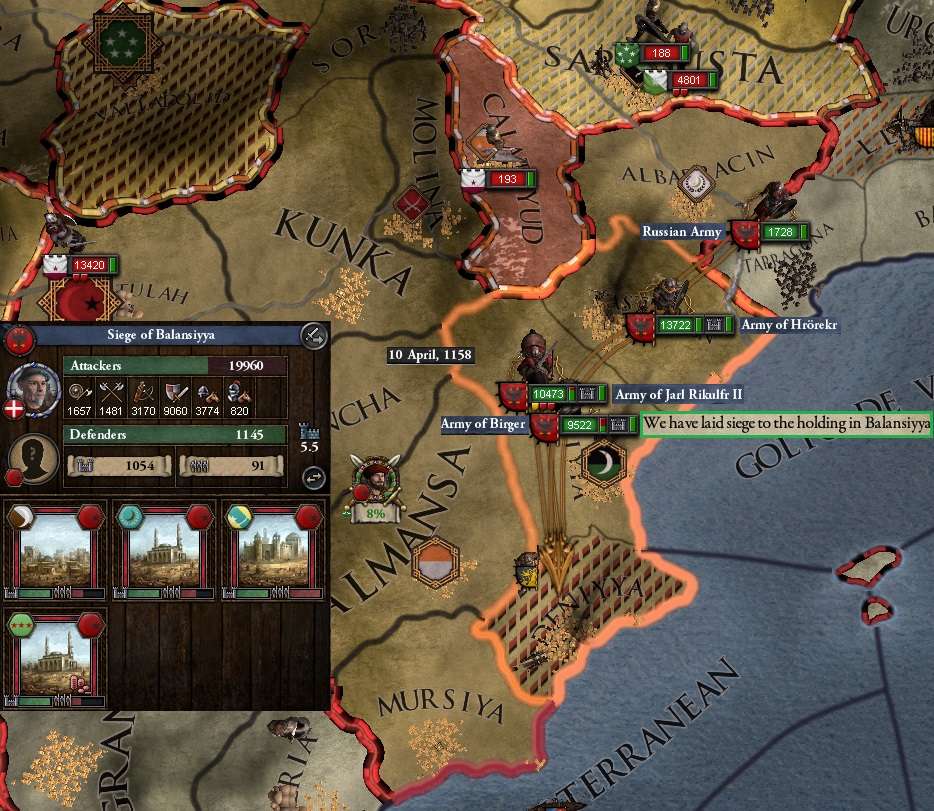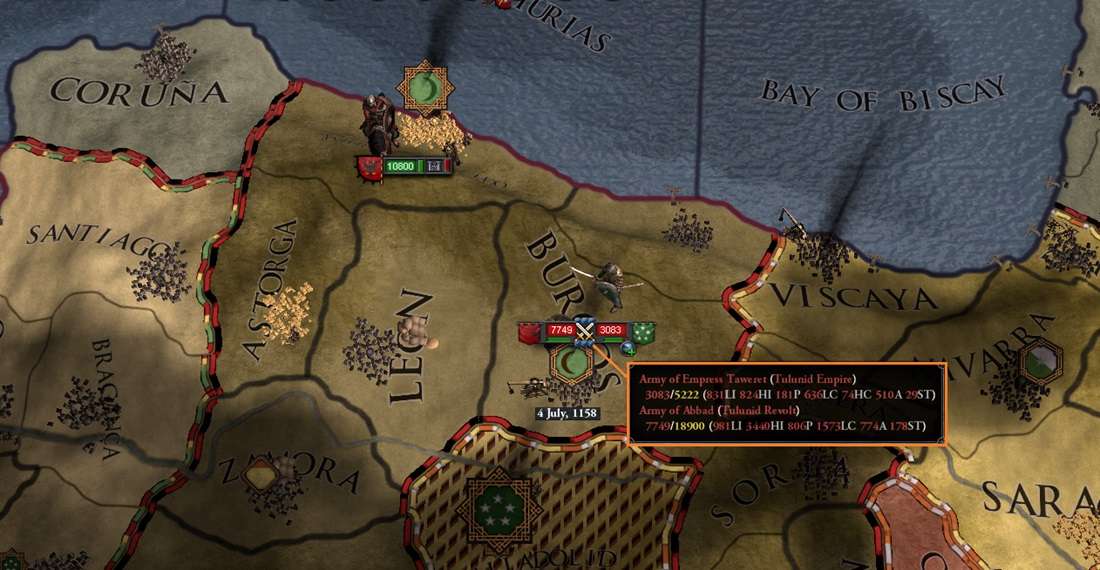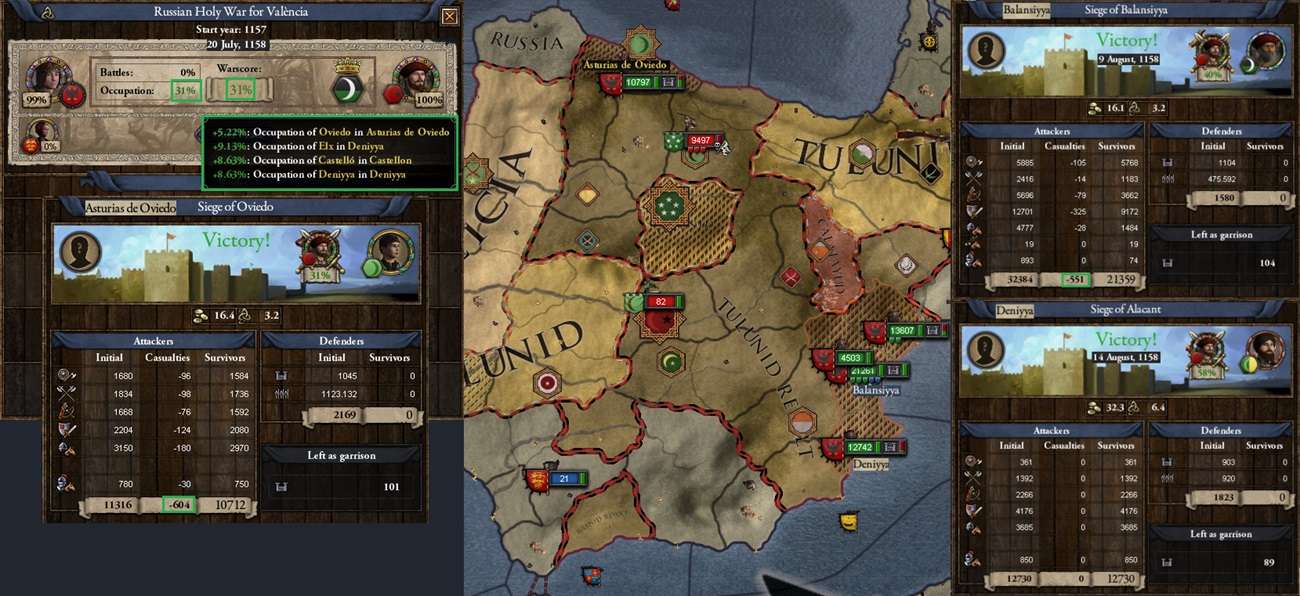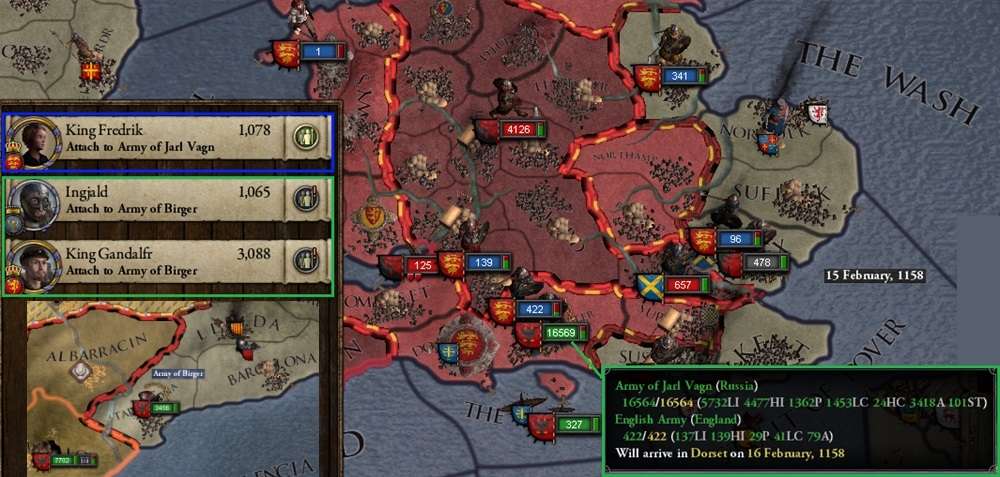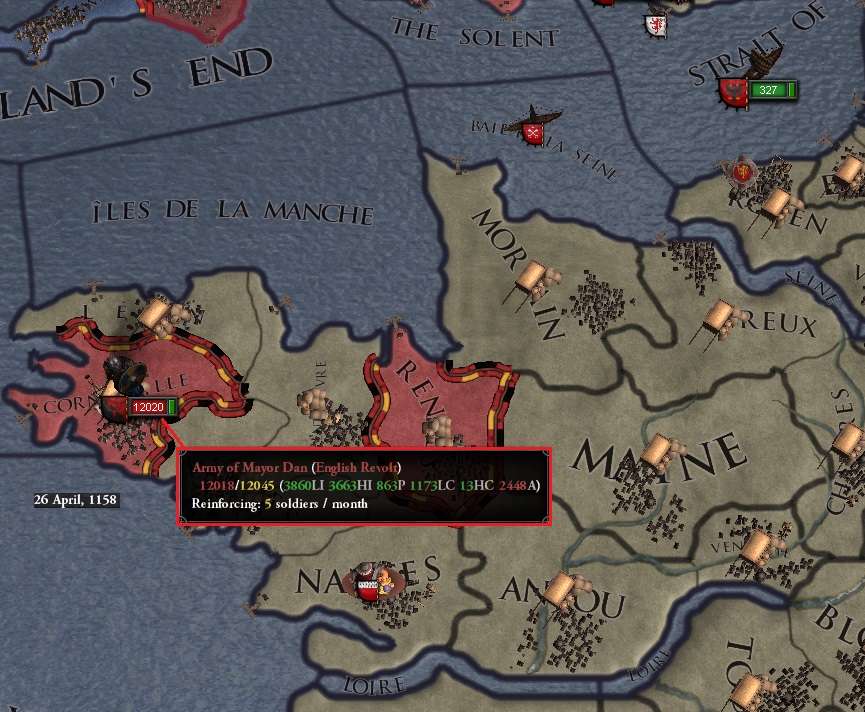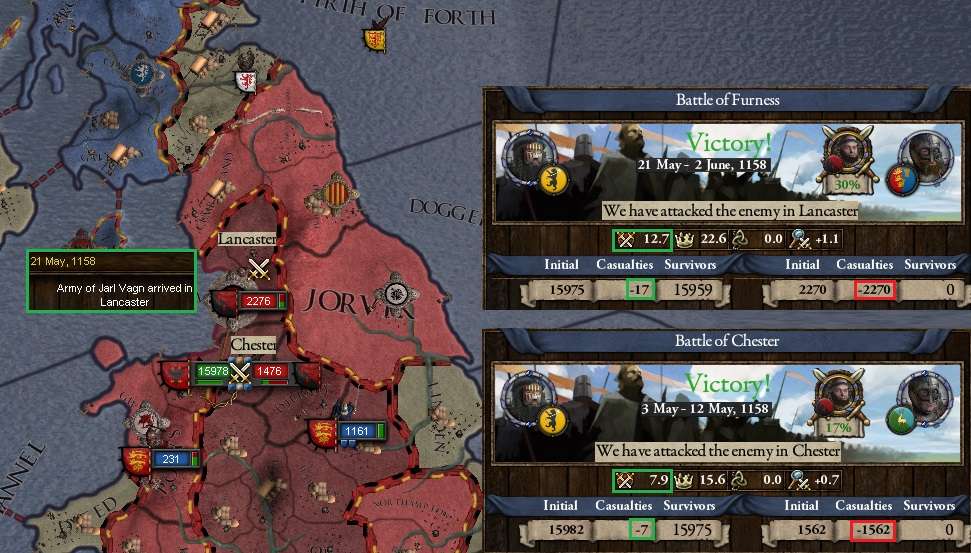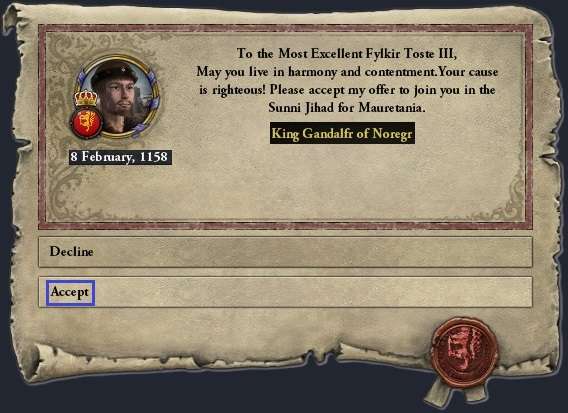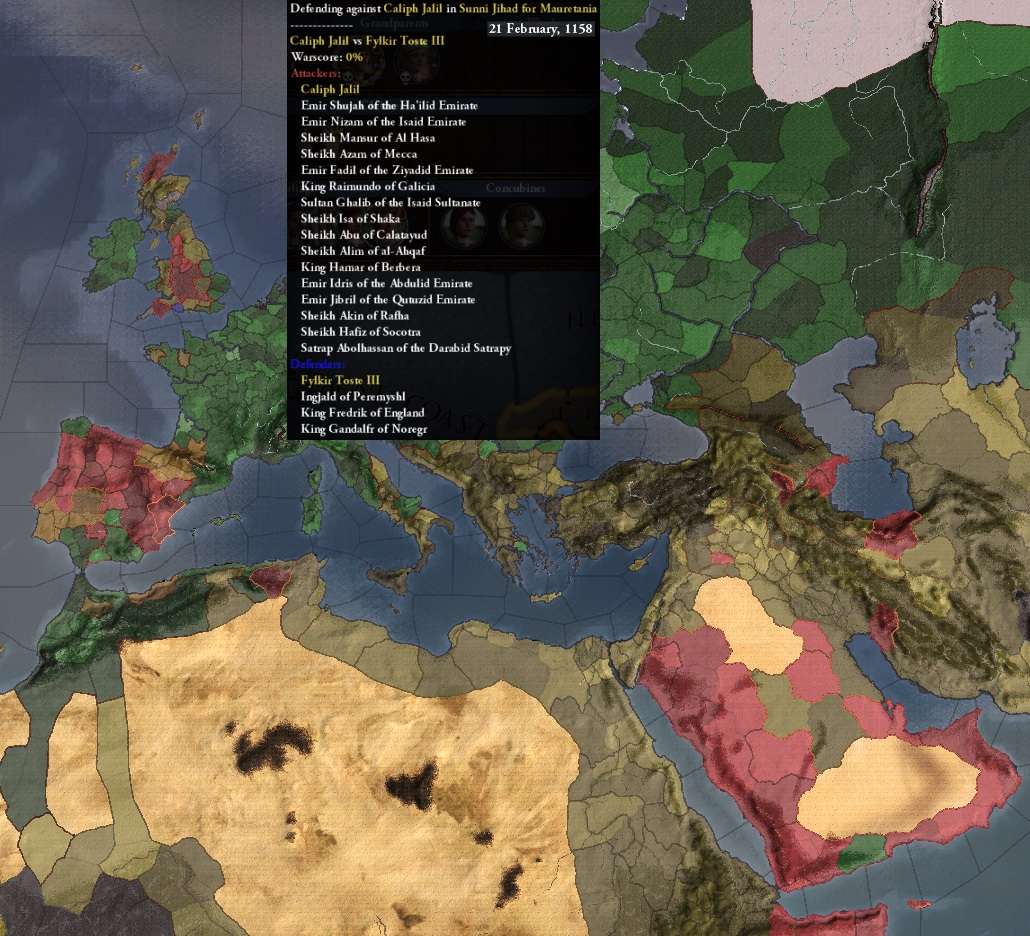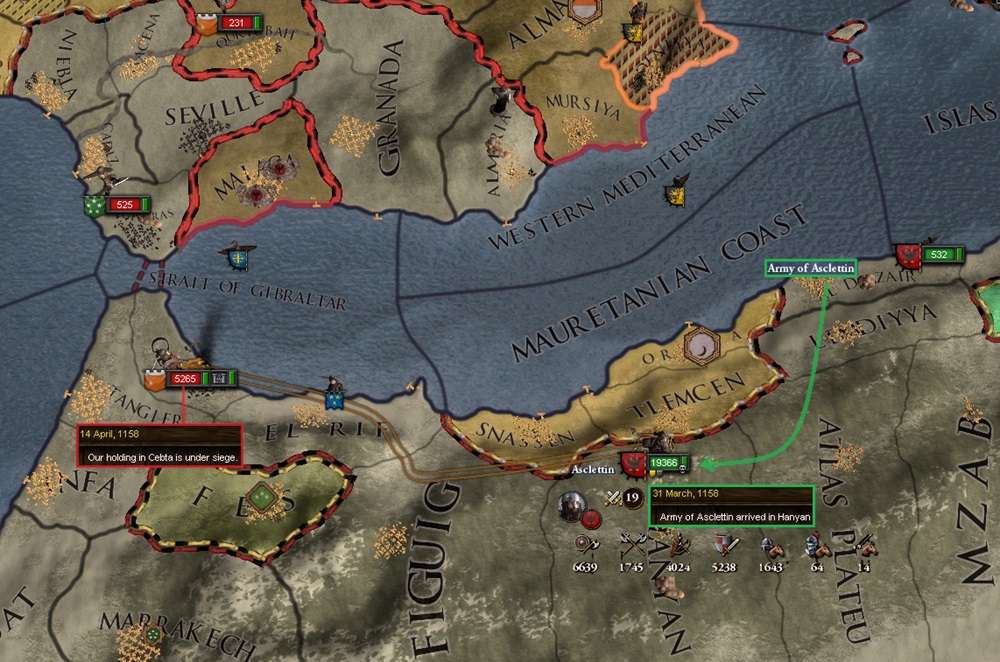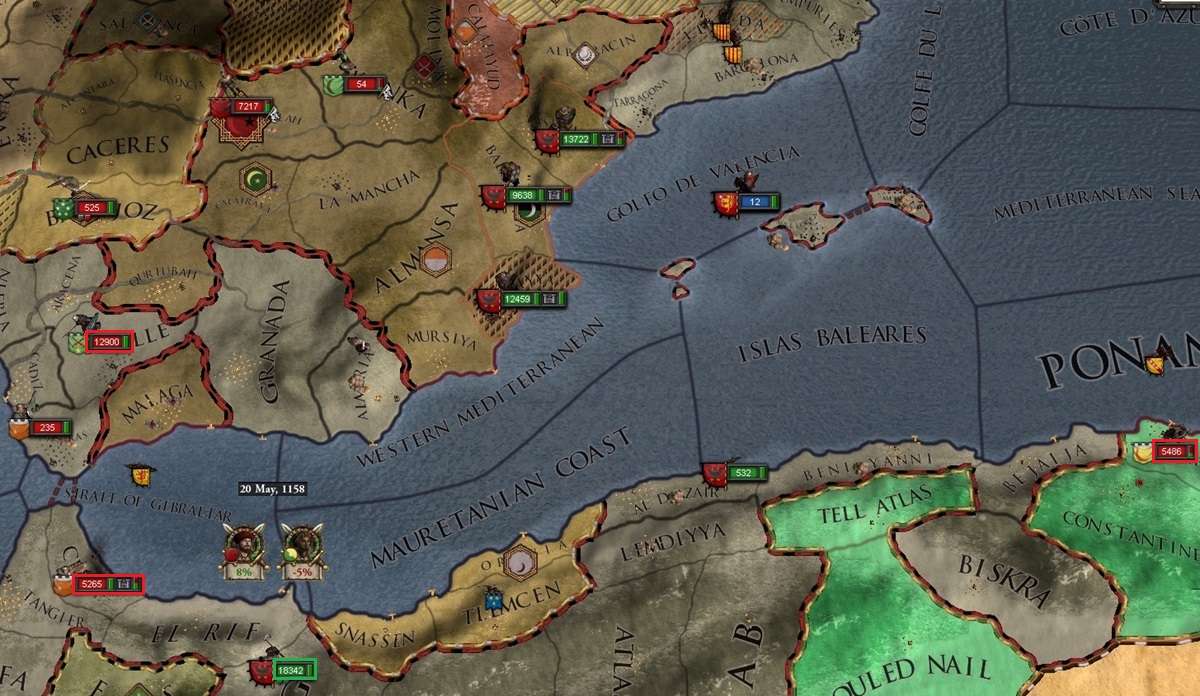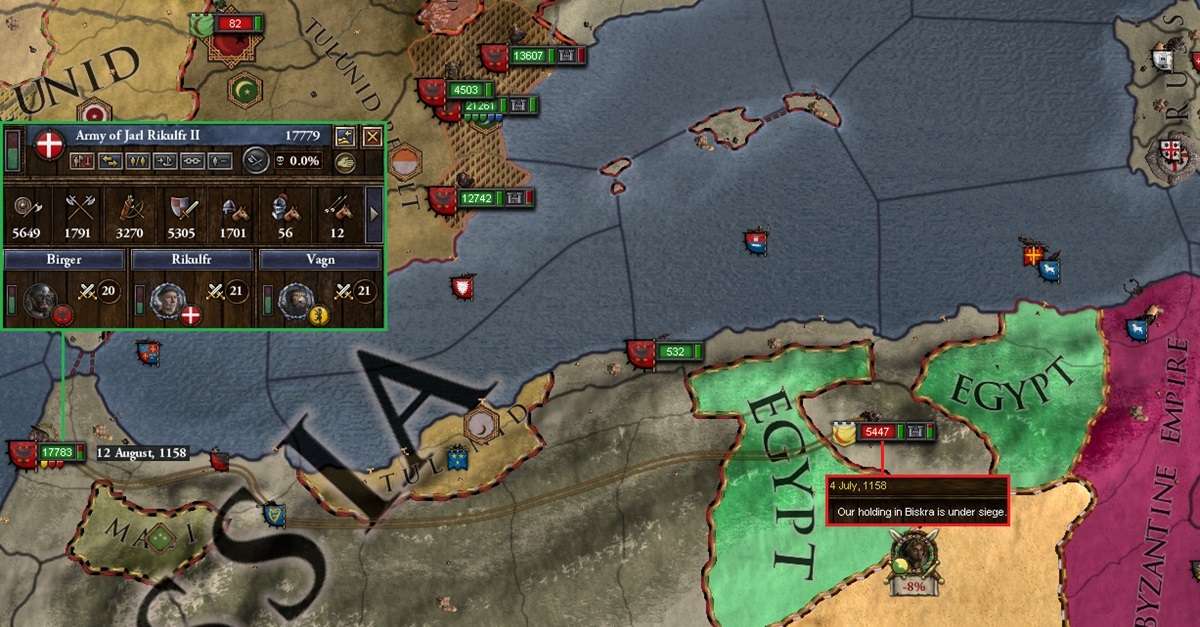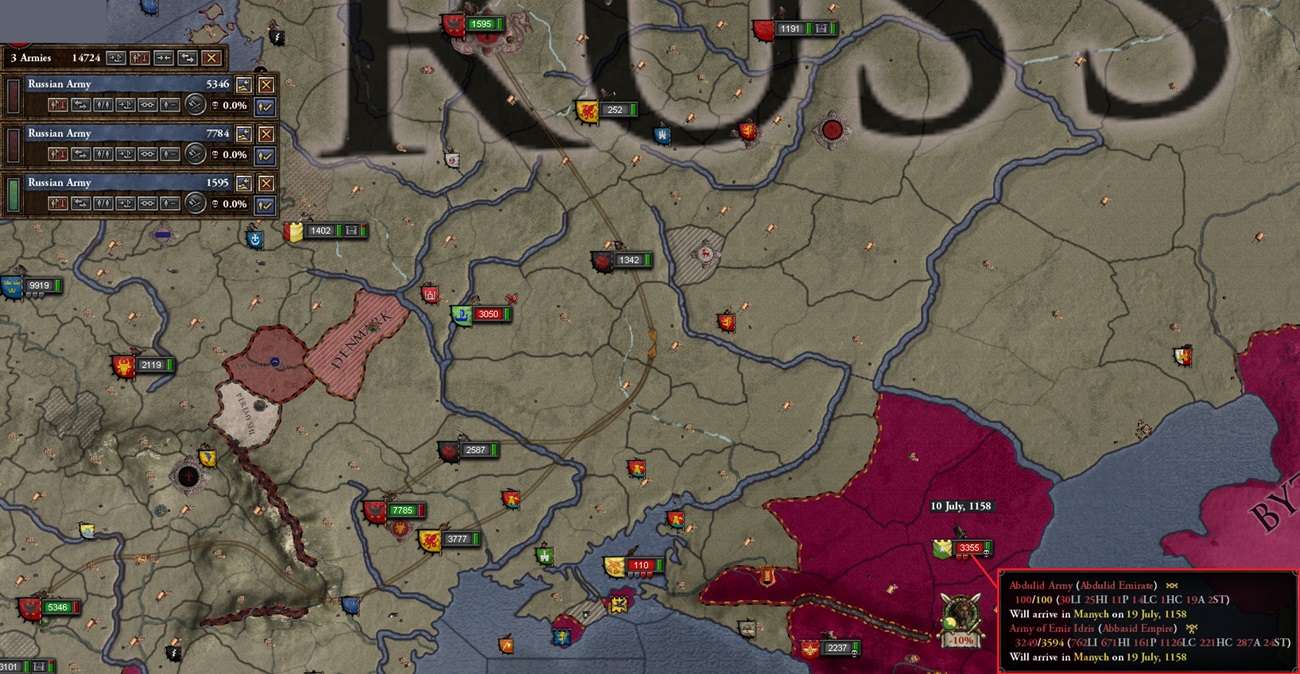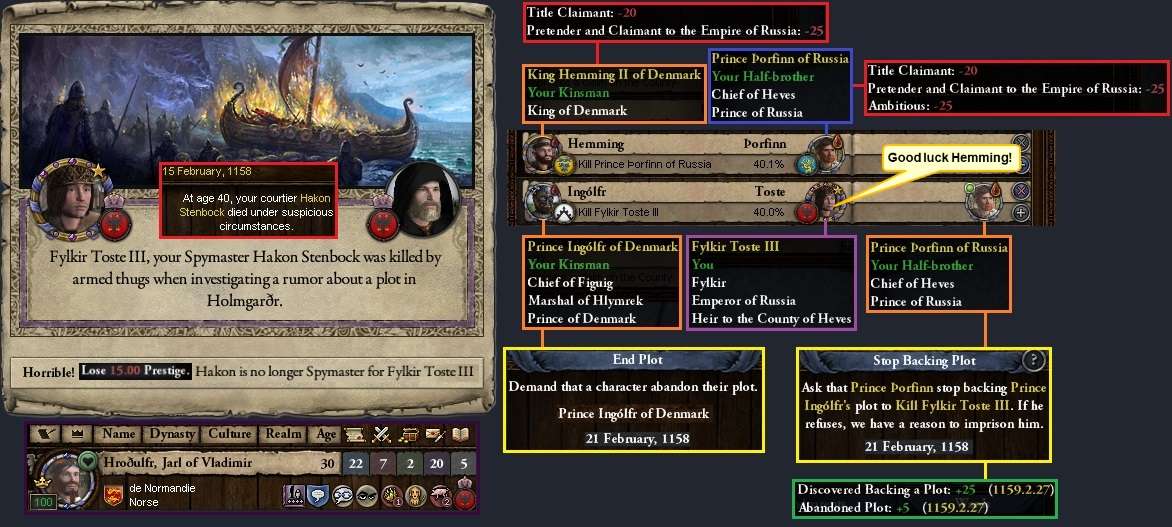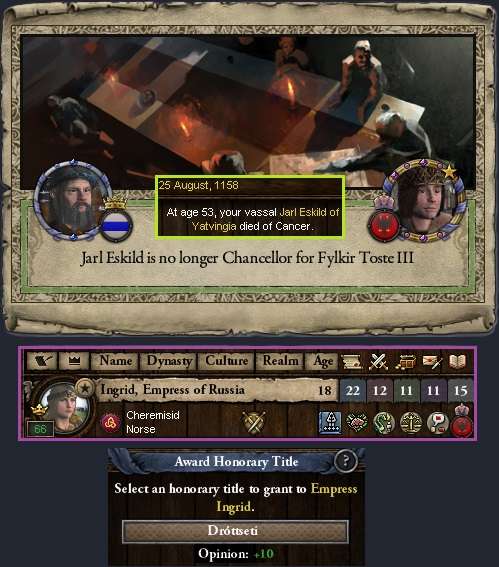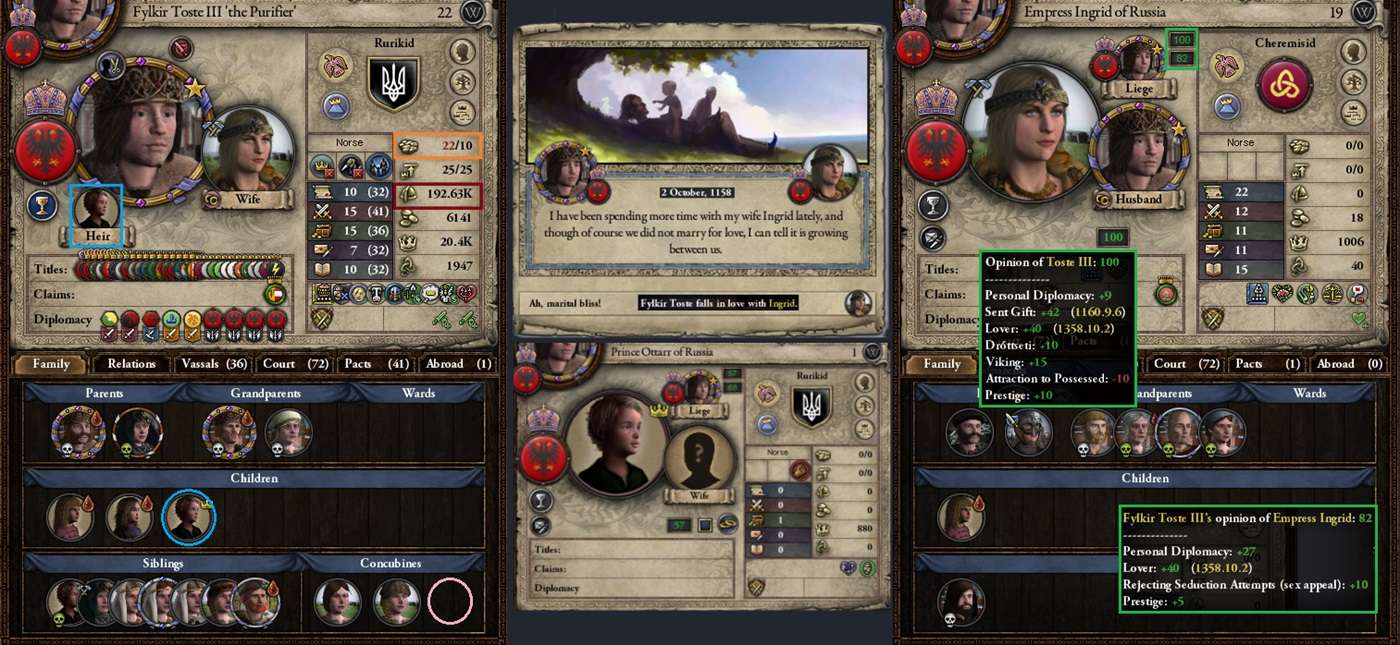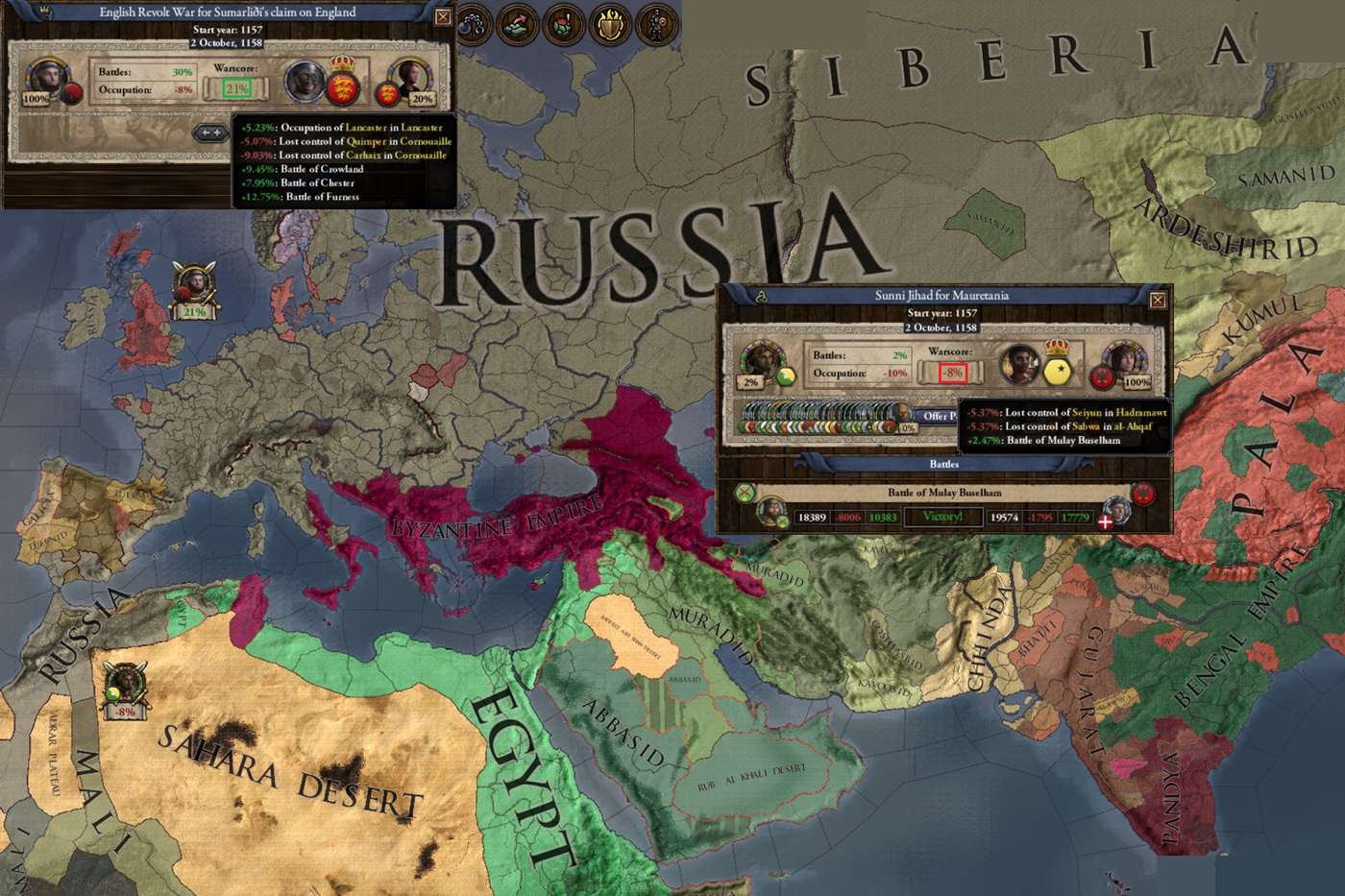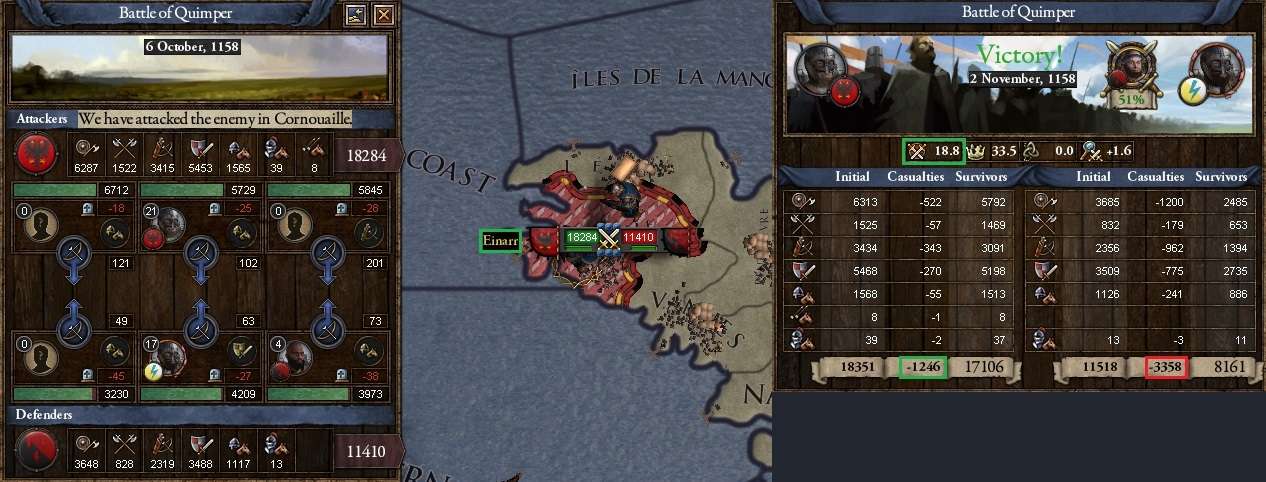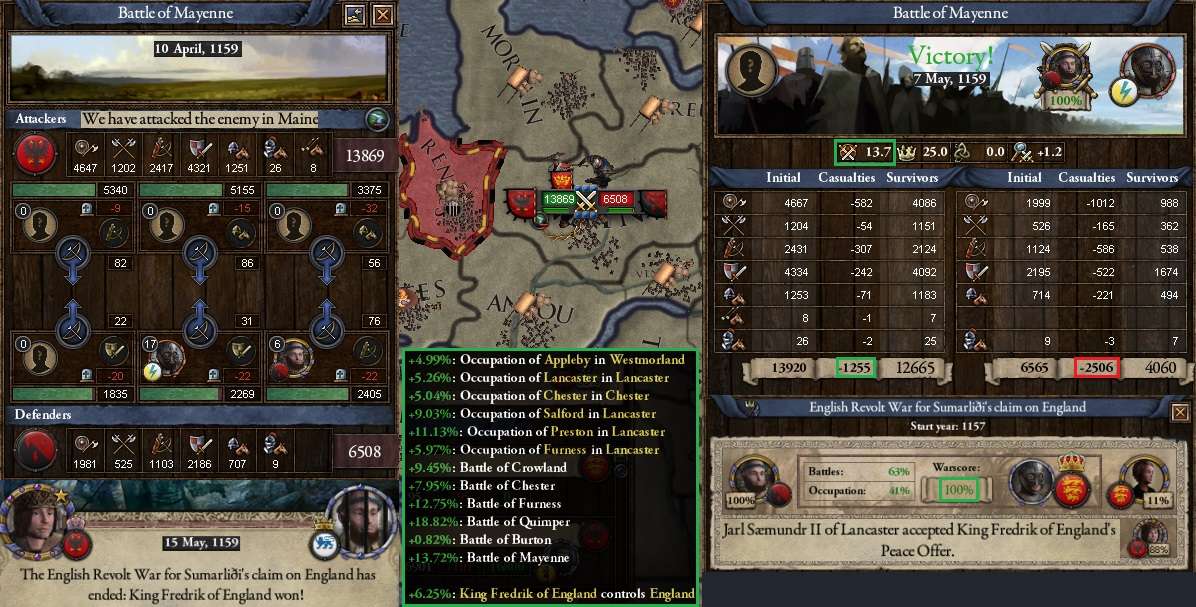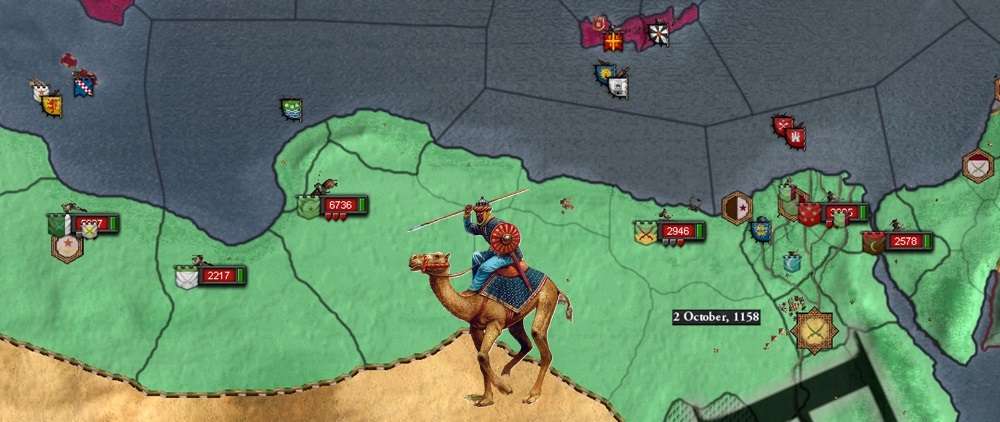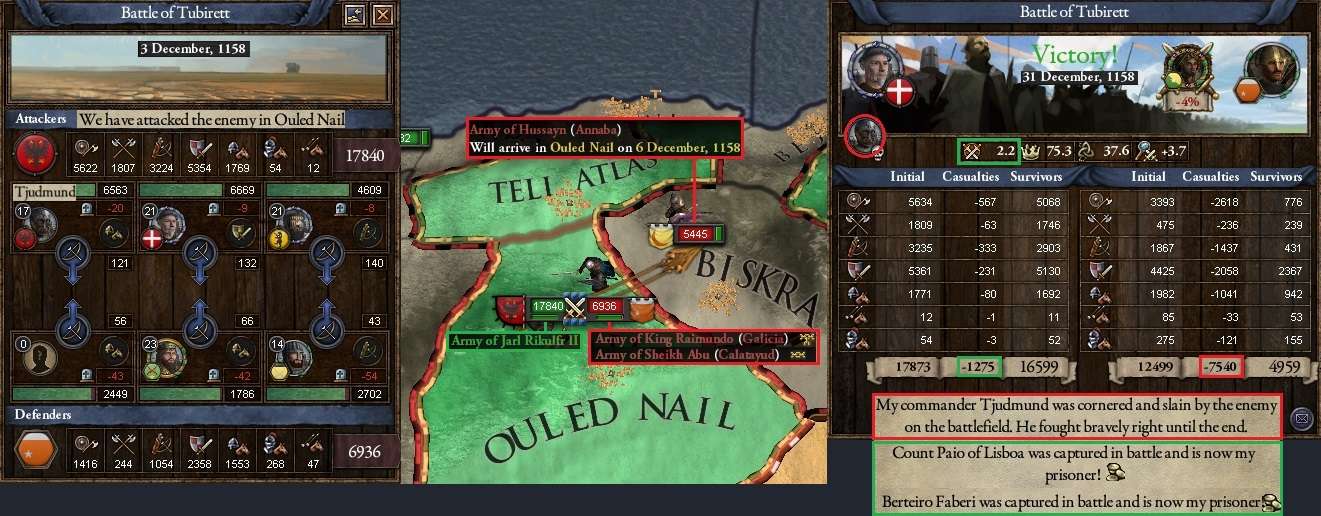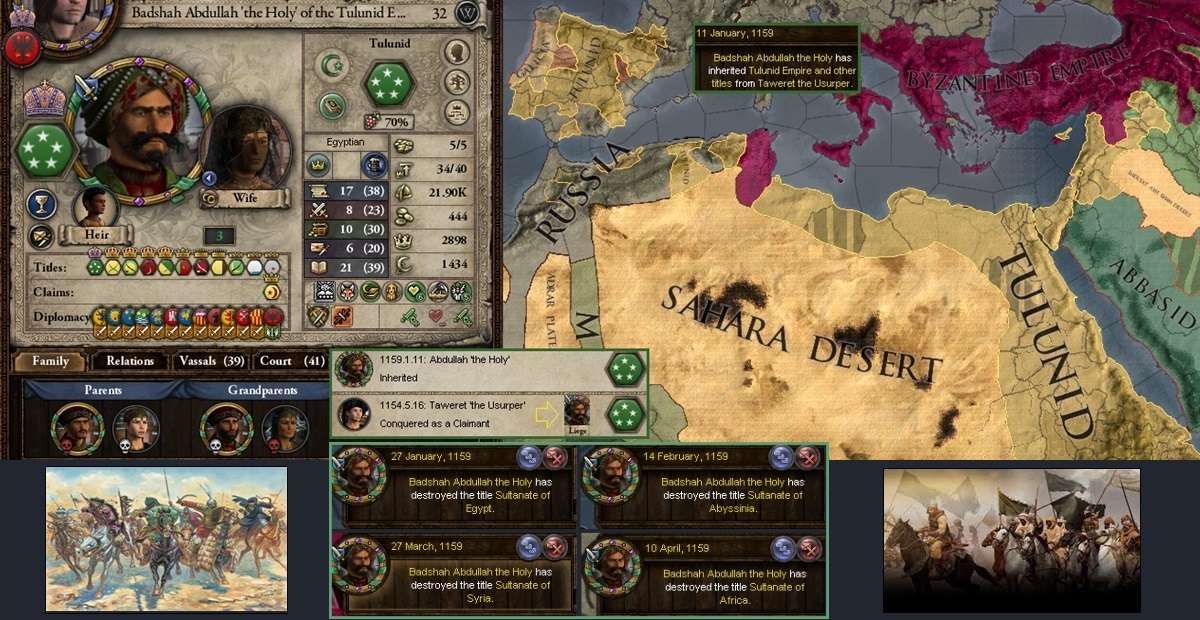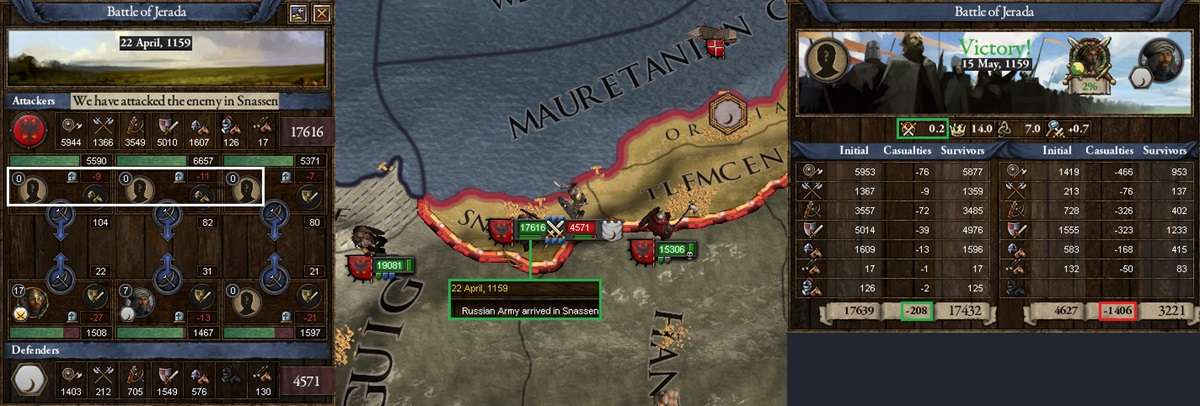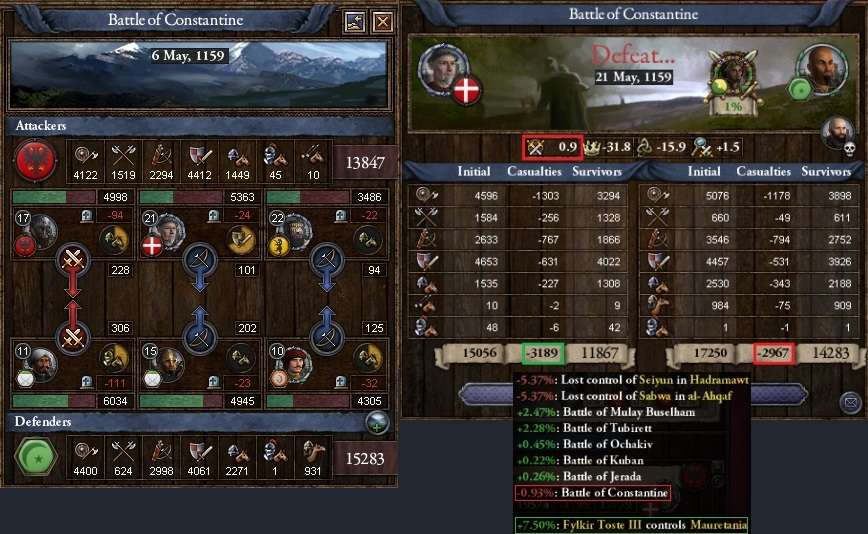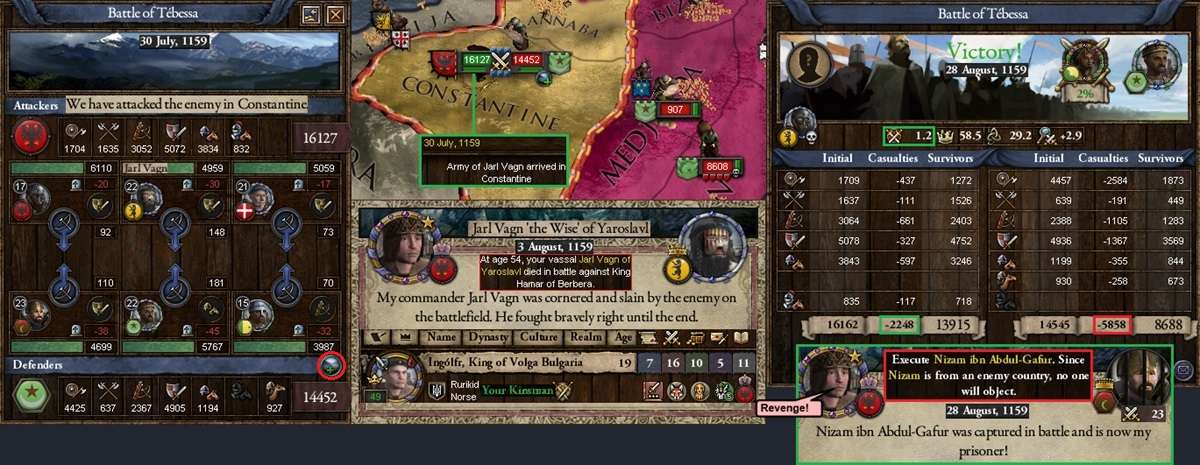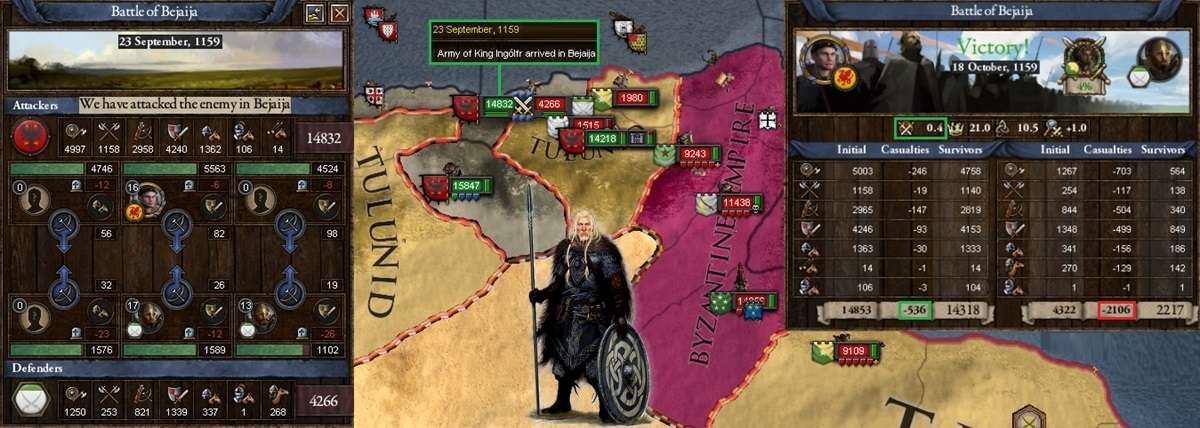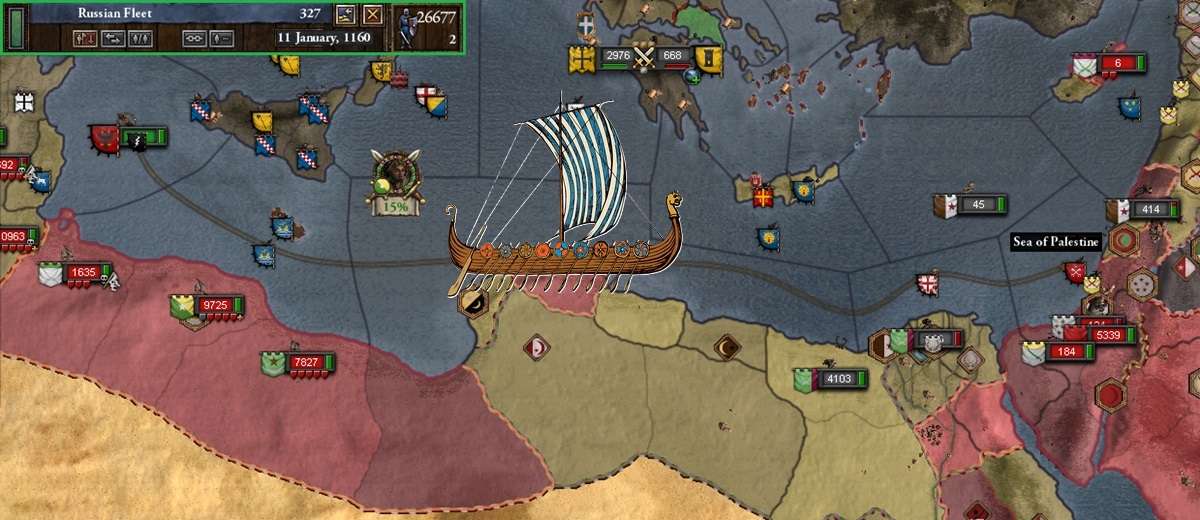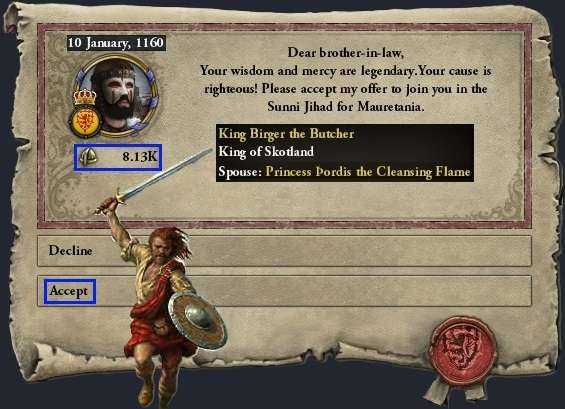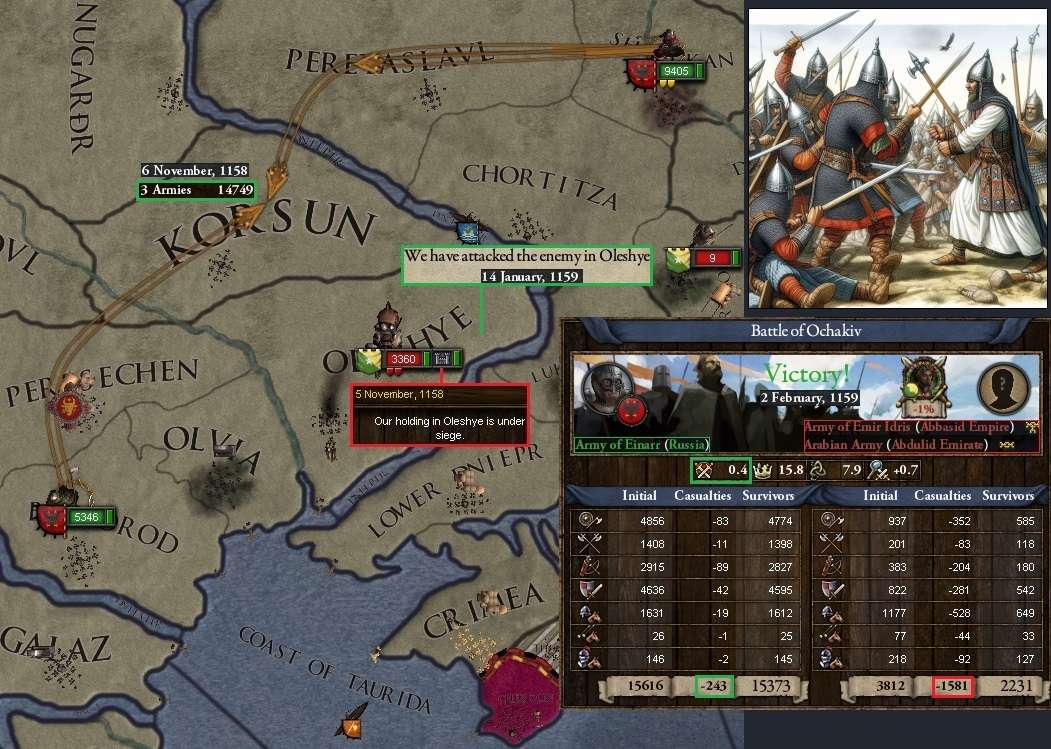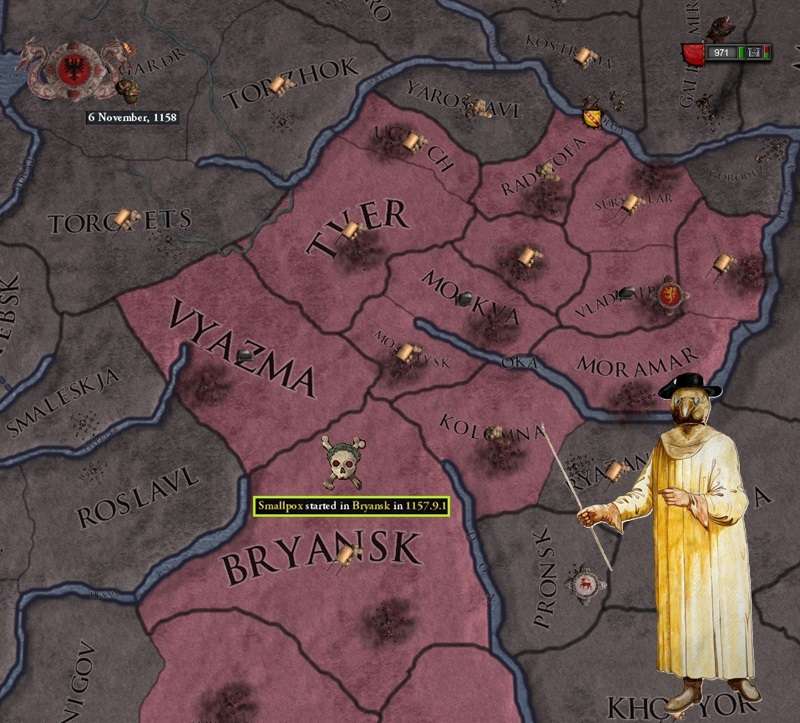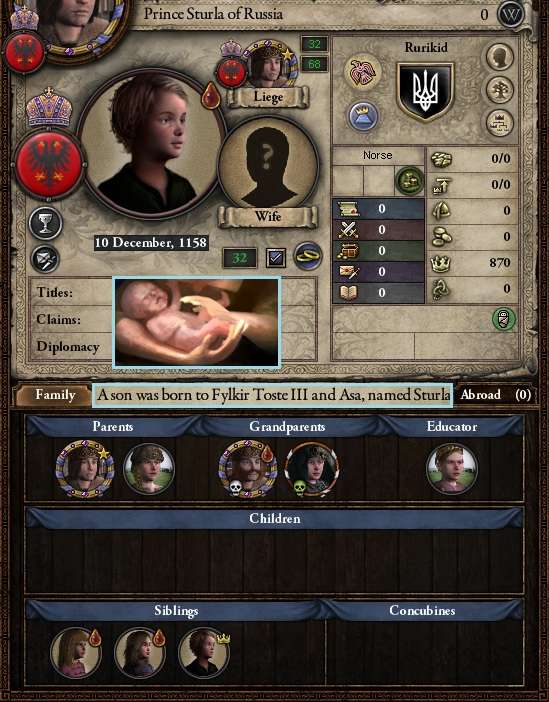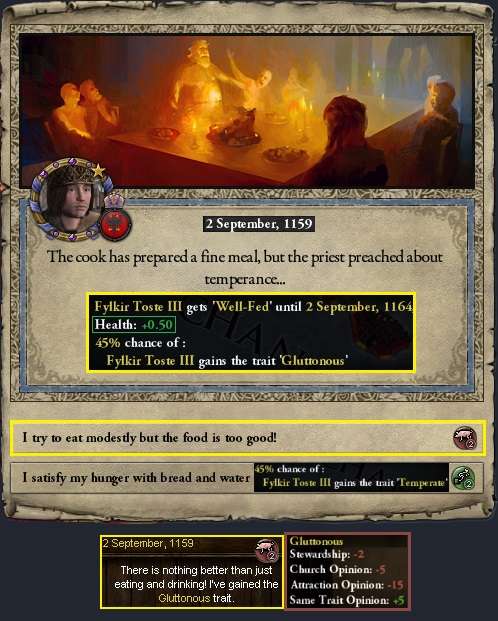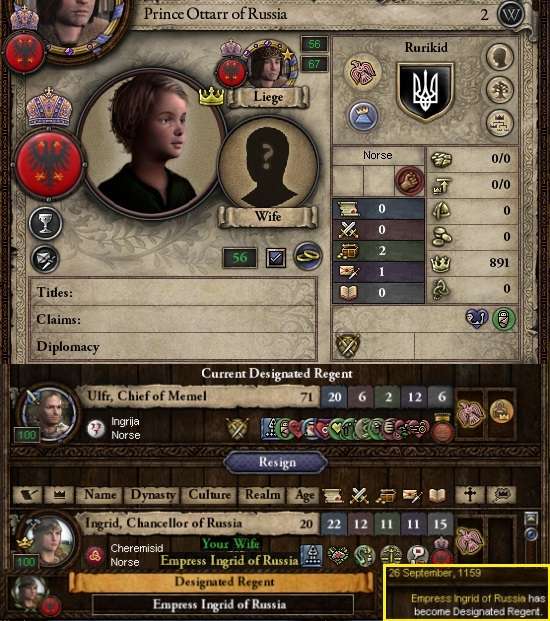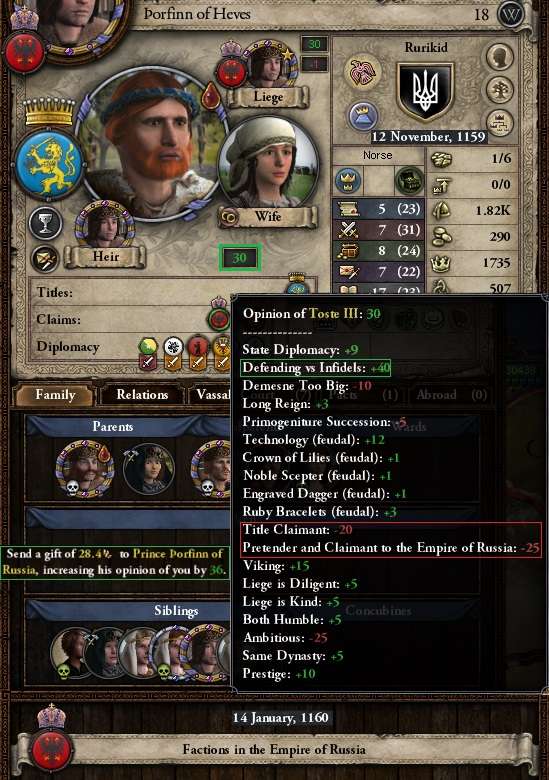Chapter 52: The Great Jihad (1158-60)
ᚔ ᚱᚢᚱᛁᚲᛁᛞ ᚔ
The English Revolt
As the English revolt was largely disabled in England itself, their main army remained intact in Cornouaille. On 6 October 1158 that came to an end when they were struck by a large Russian levy army led by Einnarr, Russia’s top field general (there were so many different armies deployed by this time that most could only afford to be given one commander each).
The battle was a routine win for the Loyalist cause, though the Rebels had put up a game enough fight. The Russians stayed on to start retaking the holdings that had been lost to the rebels in past months.
By 9 January 1159 Salford had fallen to siege, completing the occupation of Lancaster. The large Russian army split into two halves, one going north to Westmorland, the other south to Chester, where the first castle was taken on 12 April.
The rebellion was finally defeated in the field. Their army had eventually rallied and moved north, heading through Anjou to Maine. The Russians had retaken both holdings in Cornouaille by 21 February and chased the Rebels down in Maine, where they attacked on 10 April. Another tough battle was fought out, but the now ‘leaderless’ (by a recognised commander) Russians prevailed.
This prompted negotiations to begin on 7 May and by the 15th, the rebel leader Jarl Sæmundr II had signed their capitulation. Toste’s young nephew Fredrik’s throne had been secured, thanks largely to his powerful uncle’s assistance.
This meant the troops used would now be free for redeployment to fight the Jihad for Mauretania.
ᚔ ᚱᚢᚱᛁᚲᛁᛞ ᚔ
Jihad in North Africa: The 1st Battle of Constantine
The main – but not only – front for the Mauritanian Jihad from 1158-60 would be in North Africa. On 2 October, reports from coastal observation showed thousands of Jihadists from many countries making their way through Tulunid Libya to the main front, then to the east of Byzantine Tunis.
Jarl Rikulfr II was passing through Tulunid Ouled Nail towards besieged Biskra when he encountered the Galician-Calatayud army led by King Raimundo. A local Annaban army was on its way to reinforce its colleagues and would arrive three days later.
This would not be enough to save the Jihadis from a massive defeat, but during the combat Russia’s right flank commander Tjudmund was killed in the wild melee. Two Galician nobles were captured during the pursuit: neither were accomplished soldiers, so were ransomed to help offset the considerable monthly deficit the Russians were accruing.
The commander vacancy created was used to recruit a siege specialist, Toste’s distant cousin Sörkver Rurikid. He would soon be employed in the English sieges, before joining the Jihad defence later.
No specific message was received about the result of the Hispanian civil war, but it was assumed the rebels may have won. In any case, Badshah Abdullah of Egypt ended up inheriting all of Tulunid Spain on 11 January 1159. The whole realm was united into a single Empire. Tawaret the Usurper and Silo of the revolt both survived and became Abdullah’s vassals.
From late January through to 10 April, Abdullah would destroy four sultanate-level titles as he reorganised his new realm and remained neutral in the Jihad.
As Rikulfr pulled into Biskra, spies reported the progress of over 27,000 Jihadists now snaking their way along the Libyan coast towards Tunisia.
A small enemy force entered Bejaija, to Rikulfr’s north, in March so he used the opportunity to ambush them in a narrow pass near the town of El Bekara, killing 1,315 of the 2,440 Jihadists by 31 March.
The same day, news came that Badshah Abdullah – though known to be personally a coward – had joined his newly united realm to the Abbasid Caliph’s Jihad, bringing another 23,000 men into the conflict and bringing Spain alive again as a theatre of conflict.
By mid-April, Rikulfr had pushed forward to Tulunid Constantine, attacking the lead Jihadist army. He aimed to defeat them before too many of their comrades could reinforce the fight. He took an upper hand in the initial skirmishing.
To his west, three Russian armies, one with allied contingents from Noregr and Peremyshl, were approaching him. The second of these – another without an assigned commander – engaged a newly belligerent local Tulunid army at Jerada in Snassen on 22 April. The battle would result in a useful win by mid-May, though it had delayed that army for a month.
Over in Constantine, Rikulfr’s gamble had backfired as more Jihadist reinforcements arrived. By 6 May the Russians were outnumbered somewhat and the enemy were generally fresher.
Casualties were similar on both sides, but it was Rikulfr’s men who broke first, handing the Jihad its first substantial victory on 21 May. Despite this, Toste’s retention of control of Mauretania plus the earlier string of victories had outweighed the loss of those isolated temples in southern Arabia.
ᚔ ᚱᚢᚱᛁᚲᛁᛞ ᚔ
Jihad, North Africa: The Battle of Skikda
On 23 June, the 15,400 troops who had been assisting the English around Lancaster had taken ship and were heading towards western France, where the army that had retaken Cornouaille and administered the final defeat of the rebels at Maine was now waiting.
Jarl Vagn of Yaroslavl, one of Toste’s best and most experienced generals, had marched his army to the front and by the end of July was attacking the enemy in the 2nd Battle of Constantine. He slightly outnumbered the enemy, who had similarly accomplished commanders and stood on favourable ground at the mountain stronghold of Tébessa. The Germanics had the better of the initial skirmishing, but Jarl Vagn got a bit to close to the fighting on 3 August, taking an arrow through the eye that killed him instantly.
After the battle, his commanders position would be taken up by the newly crowned King Ingólfr, but for now the centre was left without a leader. This did not stop the Russians from winning a major victory. The enemy commander, a renowned general named Nizam ibn Abdul-Gafur, was captured during the pursuit. He was deemed too dangerous an opponent to be ransomed – or indeed left alive!
By mid-August, the army in France had embarked on the passing fleet, with 28,000 troops now commencing the voyage around Spain towards Tunis. And in Spain, a Tulunid force had taken the vulnerable Alcázar de San Juan in Calatrava
[worth -4.77% warscore]. This would be a running sore in the future and will be dealt with in the Hispania section below.
A follow up Norse army won a small battle in Biskra, just west of Constantine, on 7 September (900 of 2,500 Jihadists killed) as the Russians prepared for some larger enemy armies (well over 30,000 men in total) approaching along the Libyan coast and now moving into southern Tunis.
Next came a larger battle in Bejaija, where the newly arrived King Ingólfr led his army against a mid-sized Jihadist force to great effect, killing almost half of them.
It was just as well, as reports now indicated a total of almost 45,000 Jihadists were heading their way. The Russians had almost exactly the same number gathered in eastern Algeria.
It was just a few days later when word came that the once-great but now rather reduced Samanid Shahdom had joined Caliph Jalil’s Jihad. His army was smaller than the Samanids had once commanded but it posed a potential threat to Toste’s steppe territories.
And this brought to Toste’s attention that there had been a major dislocation within the Tulunid Empire some time in the last few months. No notifications had been received, but most of Abdullah’s Egyptian lands had apparently broken away into a welter of smaller states. Most of which had
not committed to the Jihad, such as the largest of the new independent realms, that of the Hararid Emir Salim.
Only one of these would declare for the Jihad in the next four months – Emir Hussayn of the Abazids.
The climactic battle that had been brewing for weeks now in North Africa began with the Jihad pushing a large army into Annaba in October. The two Russian armies in Bejaija and Constantine coordinated their marches to arrive in Annaba on the same day, while Sigbjörn’s army followed up from Biskra to Bejaija, knowing more Jihadi armies were approaching from the east.
The two sides came together on the plains of Skikda in Annaba on 13 November 1159 in what would prove to be one of the major battles of the Jihad. Jarl Rikulfr had come to take overall command before the battle began, seeking some revenge for his earlier stinging defeat at Constantine. And despite heavy Russian casualties, the Jihadists suffered more than twice as many with well over 9,000 perishing.
Despite this, yet more Muslim troops were on their way across Libya. But it was decided in January 1160 that the Irish fleet ferrying troops from England and France would bypass the North African fighting and take the war to the Caliph himself.
No sieges on other Jihadi lands could generate leverage for victory
[ie warscore] and even big wins such as the most recent one only contributed small amounts to the victory stakes. An invasion of Palestine would hopefully mean this war would not last for the many years it seemed to be heading for otherwise.
With no more significant fighting in North Africa for the few months following the Battle of Skikda, the fleet arrived in the Sea of Palestine in early March. Rikulfr would command one army of around 14,000 to land in El-Arish, while Sörkver the siege master would lead around 12,500 men in a risky opposed landing against 4,000 defenders in Asqalan, two counties to the north.
ᚔ ᚱᚢᚱᛁᚲᛁᛞ ᚔ
Jihad: Hispania
In early October 1158, Empress Taweret was still defending a revolt against her ‘tyranny’, now uncomplicated by the just-finished Russian intervention in València. Those troops were about to head off to North Africa to meet the coming Jihadist threat.
Taweret looked to be losing quickly now and as we saw earlier, would lose her fight and be subsumed under united Tulunid rule later that year.
After the entry of Galicia into the Jihad, the Russian reserve army that had been recovering from the Valèncian campaign in Coruña decided in late January to move south to Santiago to see if they could do any good.
They would take Santiago Castle on 25 April and it confirmed that taking the holdings of non-Abbasid Jihad members would do no good. Instead, they planned to hook around back through Coruña to Oviedo, to see if they could catch an approaching Tulunid army there ‘for a bit of sport’. But the enemy always seemed to keep a move ahead of them.
September found the Norsemen in central Spain after a few small skirmishes along the way, heading under Sörkver’s command to take Alcázar de San Juan in Calatrava, which had been taken some months before. They would need to fight another small engagement on their way south.
With Spain now crawling with small Tulunid forces mobilised after the unification of the country under Abdullah and his entry into the Jihad, the remaining western vassal levies, around 3,200 men in total, were called out on 5 October 1159 and ordered to concentrate in southern France for employment in Spain.
Sörkver quickly took Alcázar de San Juan by assault on 10 November and headed south to chase a Tulunid army that had just crossed the Strait of Gibraltar to no doubt create mischief behind the lines in the Jihad’s target, Mauretania. Sörkver hoped to pick up around 3,600 Norwegian allies who were then to the south in Malaga.
Then in January 1160, there was welcome news when Toste’s brother-in-law, King Birger ‘the Butcher’ of Skotland, volunteered to defend Germanicism. His army of over 8,000 men would eventually take ship and arrive in Spain later that year.
Jihad: Southern Russia
By 5 November 1158, the raiding Abbasid army had reached Oleshye and started a siege. The gathering Russian responders, which included a Young Guard detachment from the capital and a range of levies from Hungary and Russia, aimed to concentrate in Korsun, where they would have a clear line of advance to attack the enemy.
It would take until early February 1159 to press home the attack, which was done with devastating effect, the pre-eminent Russian general Einnarr having taken command of the army for the occasion. They would pursue the invaders east past the Sea of Azov.
Just as they were closing in on the Abbasids in Kuban in mid-March, word came that a larger Jihadi army (around 4,600 men) had arrived and started besieging Aqtöbe, north-east of the Caspian Sea. Einnarr would have to remove the enemy at hand first before the new threat was dealt with.
Einnarr wiped out the second small Abbasid army in Kuban on 1 April, giving no quarter. He let the other routing army continue to flee as the march east to Aqtöbe started.
As they were nearing the beleaguered fort in late July, reports were received of its fall
[-4.11% warscore]. A grim revenge would be taken for this outrage as Einnarr, assisted by top commanders Birger and Asclettin, closed in on the enemy on 9 August. After the victory, the enemy’s formidable commander, Esfandiar the Hunter, was taken prisoner. Again, he got the headsman’s axe for being ‘too good at his trade’.
After the Samanids declared for the Jihad, that Norse army started moving further east, aiming to skirt to the north of the Caspian Sea and then hook south to guard the border with the Samanids in case they mounted an invasion. And on 5 October, the remaining Russian levies were called out, another 21,000 men to concentrate at the Black Sea port of Oleshye, ready for whatever tasks may arise in the next phase of the Great Jihad.
Around 8,800 of these troops were sent to gather to the east when scouts reported the 2,600 remnants of the Battle of Aqtöbe had rallied and were heading back towards central Russia. The rest of the troops had by then arrived in Oleshye, awaiting further orders.
ᚔ ᚱᚢᚱᛁᚲᛁᛞ ᚔ
Domestic, Court and Dynastic Affairs
Against the tumultuous background of the Jihad, which eventually brought about the first complete Russian mobilisation in many decades, there was some upheaval at home as well, interspersed with better news.
All through this period, a firm eye was kept on the treasury. On 2 October 1158, it stood at nearly 6,000 gold crowns, but the monthly deficit was 120 gold (income 63, expenses 183, most on retinue upkeep and reinforcement, a far smaller amount on levy upkeep) and usually hovered from 100-110 throughout as both combat losses and attrition demanded coin to service the war. With no raiding possible, a steady flow of ransoms from some captured commanders and prisoners taken in sieges would provide some supplement.
At the end of the month, the irritating presence of Jarl Folki of Dauphine again became an issue – and this time, with a Viking reputation and his Warden armour to protect him, Toste decided enough was enough. The mangy dog was challenged to a holmgang!
In the end there was no risk as the cowardly Folki declined the challenge - he must have assessed the odds and not liked them. Hopefully this would now put him in his place.
A few days later, to celebrate, Toste recruited a new concubine, the young and lusty Ulfhildr af Holmgarðr, to bring his complement of ‘intimate companions’ back up to three again. With only one rather frail infant heir, he wanted more spares to guarantee the succession of his line.
And there seemed to be evidence that all that investment in hospital infrastructure in the home counties was paying off: a smallpox epidemic that had broken out in Bryansk over a year before had not spread into either Toropets or Torzhok, providing a buffer for the capital.
Then Asa’s pregnancy ended in an excellent dynastic result in December: a healthy second son named Sturla was welcomed into the Imperial family.
Though the Fylkir’s mood was soured a few days later when a drunken conspirator spilled their guts – and the beans – on the plot to kill Count Rudolf. Which despite its strength still seemed to be going nowhere. Toste kept trying anyway.
Toste only remembered the need to divest himself of those excess holdings from the Valéncian Holy War at that point. He would keep the well-developed regional capital for himself, the rest distributed to those powerful magnates whose support needed shoring up at that point.
Jarl Rikulfr II ‘Son of Hel’ of Savoy and the now cowed Jarl Folki II of Dauphine (personal animus not getting in the way of politics) were both given counties. Warchief Bo of the Jomsvikings and King Jedvard Rurikid of Volga Bulgaria were both given subordinate titles in Valéncia.
Then as the year was drawing to a close, Empress Ingrid announced her latest pregnancy: a third son, Halsten, would be born eight months later.
The good news kept coming, with Seer Gnupa reporting his successful conversion of Almiera in southern Hispania to Germanicism in late January 1159. Another useful snub to the Jihadists.
A month later came new that feuding within the Rurikid clan governing Volga Bulgaria via a war against the tyranny of old Jedvard the Butcher had ended in victory for the rebels. By some political manoeuvring Toste could not exactly decipher, Ingólfr Rurikid became the new King. He would later be deployed to fight in the Jihad as a commander after the death of Jarl Vagn in the 2nd Battle of Constantine in August that year.
The latest outrage from the ‘Bad Brother’ Prince Þorfinn was news in March of a plot to kill Toste that had been detected by the Spymaster, with a standard ‘cease and desist’ letter being sent automatically, which Þorfinn would submit to.
Things at home were relatively quiet for the next few months, until a few weeks after the birth of young Prince Halsten Toste acquired a nasty headache that would just not go away …
A mildly successful treatment was administered by Court Physician Gnupa, who thought it might be a case of dysentery. In late August a fever was added to Toste’s woes. Uh oh …
Planning to ‘eat the fever away’ Toste self-medicated by going on a feasting binge. Perhaps that would help … or not!
But still. He’d known the risks and wanted the health benefits, though alas it resulted in him becoming a glutton. At least by this time the smallpox epidemic was starting to abate, never having broken into the home counties.
Later in September Gnupa was called back – now he thought it was the flu and the treatment he provided was excellent. And so too this latest diagnosis.
With the illness setting in, Toste asked to see his heir Ottarr, still only 2, and the Empress. Toste thought Old Chief Ulfr was ‘getting past it’ and Ingrid, now also Chancellor, would make a better regent anyway in case the worst happened. The change was made.
This proved a prudent precaution, as Gnupa returned in mid-October to review Toste’s progress. One of the options he offered was a mystical treatment. Interested in this novel approach and having hired Gnupa as a mystic healer in the first place, Toste placed his trust in this treatment. It was a decision he soon came to regret …
… many thought the Fylkir, who had cheated death as a child by beating the Bubonic Plague, had finally run out of luck as his life hung in the balance. Even if it would in time make him a kinder, humbler person. If he lived!
But even as illness and its ‘cure’ debilitated Toste, there was a ray of light. In part due to solidarity in the face of the Muslim threat and perhaps some healing of old wounds, Prince Þorfinn’s opinion of his
half-brother had improved since the murder plot earlier in the year.
Hoping to bring about a rapprochement, a small sum was sent in November as a gift that would boost that opinion even further. And by January 1160 Þorfinn had left both his factions … meaning there were none at all in the realm at that time.
And it is clear from the court records of the time that Toste may have been ill but was not incapacitated. New concubine Ulfhildr was pregnant by the end of November 1159.
ᚔ ᚱᚢᚱᛁᚲᛁᛞ ᚔ
The new year came and Toste was still alive … and Gnupa visited once more offering a new treatment. This time, Toste opted for the conservative choice – which despite its stinkiness turned out to be an excellent one!
The mystic side-effects were banished early, his abilities returned – less the gluttony but retaining his ‘well-fed’ benefits. On 9 February, with a now sufficient family and needing to boost his rulership abilities, Toste changed his focus to better balance his demesne and vassal management.
Later that month, he decided the accomplished commander Einnarr would be a better choice of educator for the Crown Prince than the Court Tutor, given Orttarr’s initial education in the ways of struggle.
Though Toste was still not clear of the flu and remained in some danger,
perhaps he had survived the wort part of the illness that had come with his seemingly misplaced trust in ‘mystic healing’ methods, emerging as a better man. And he still had a Great Jihad to contend with, as the Caliph’s reserves of willing warriors from across the Sunni realms had proven larger than the Germanics had anticipated.
